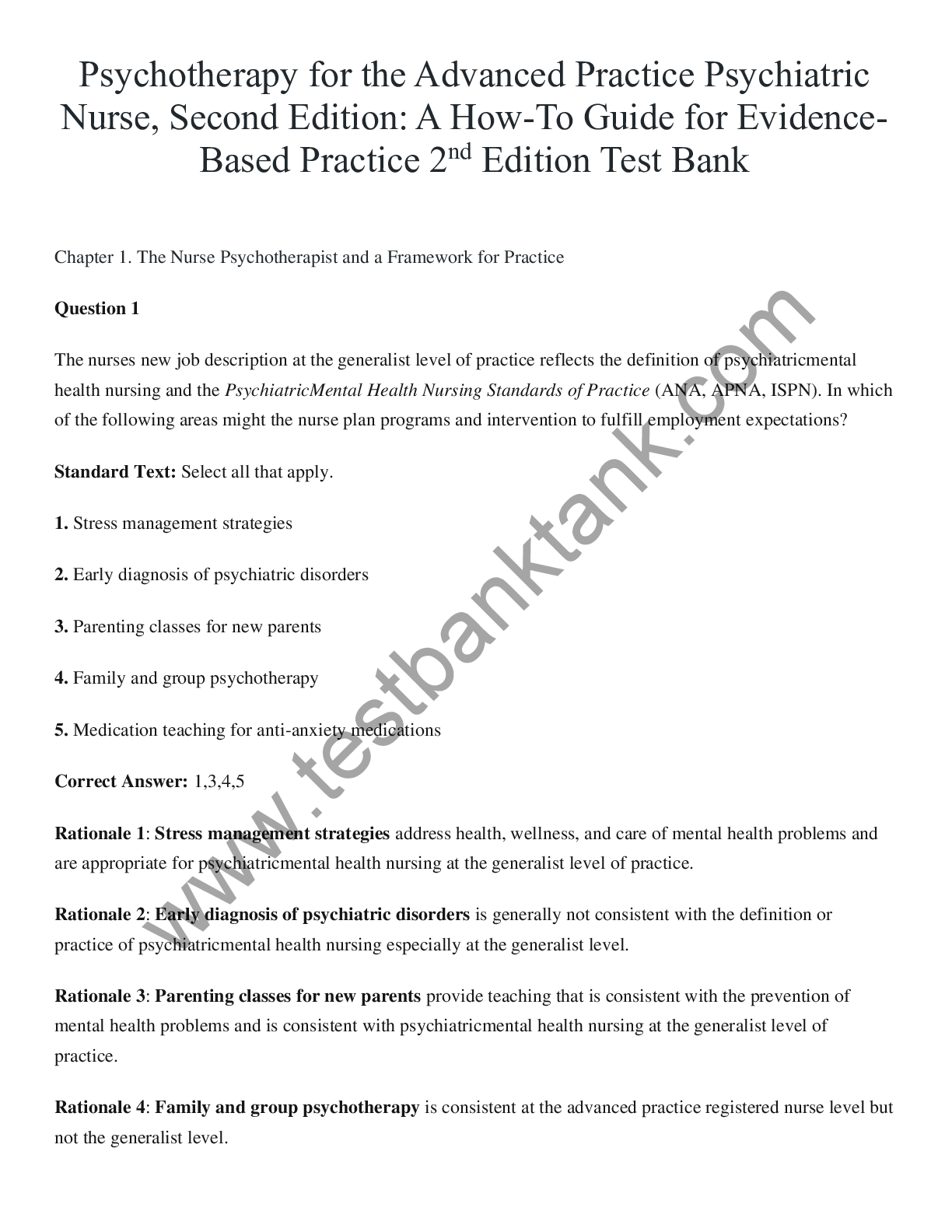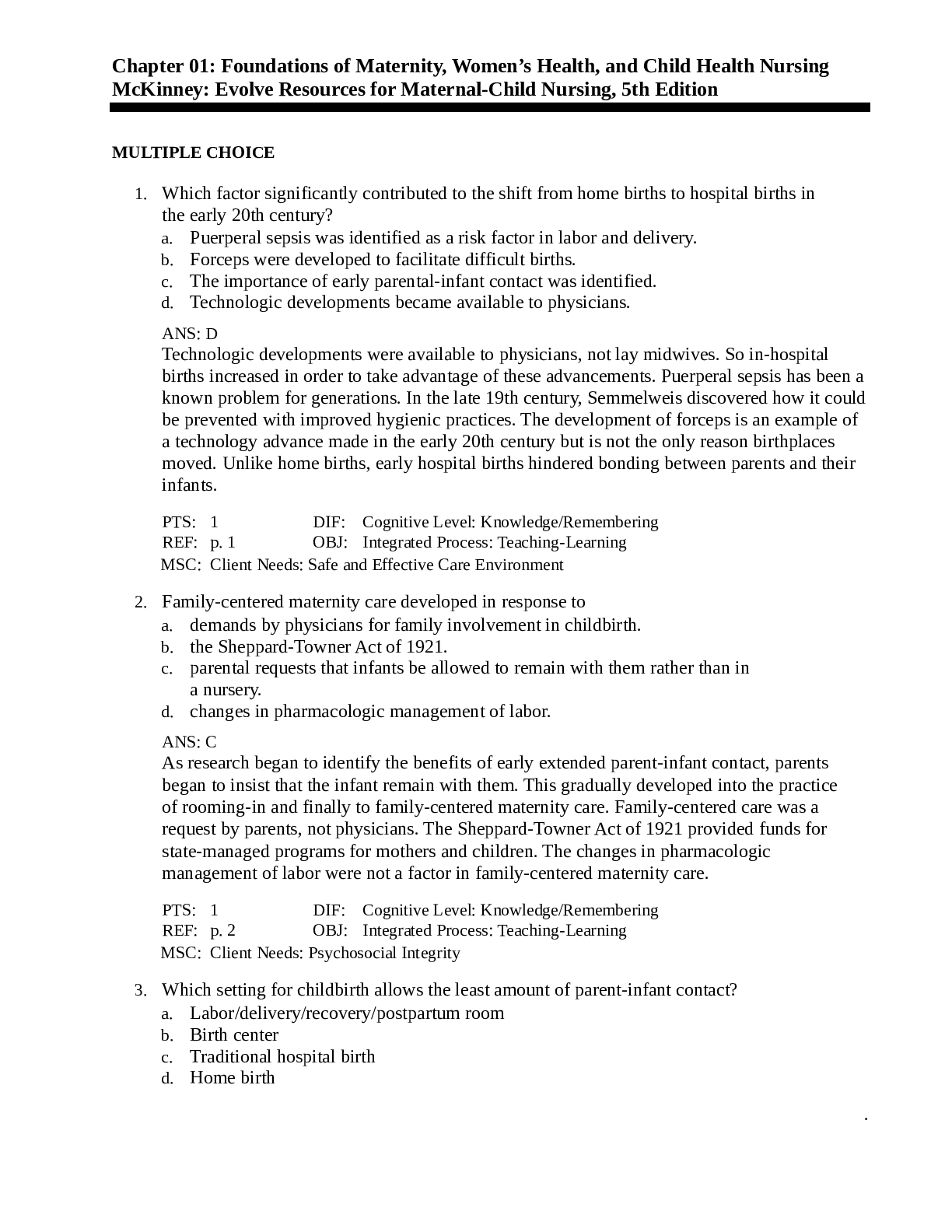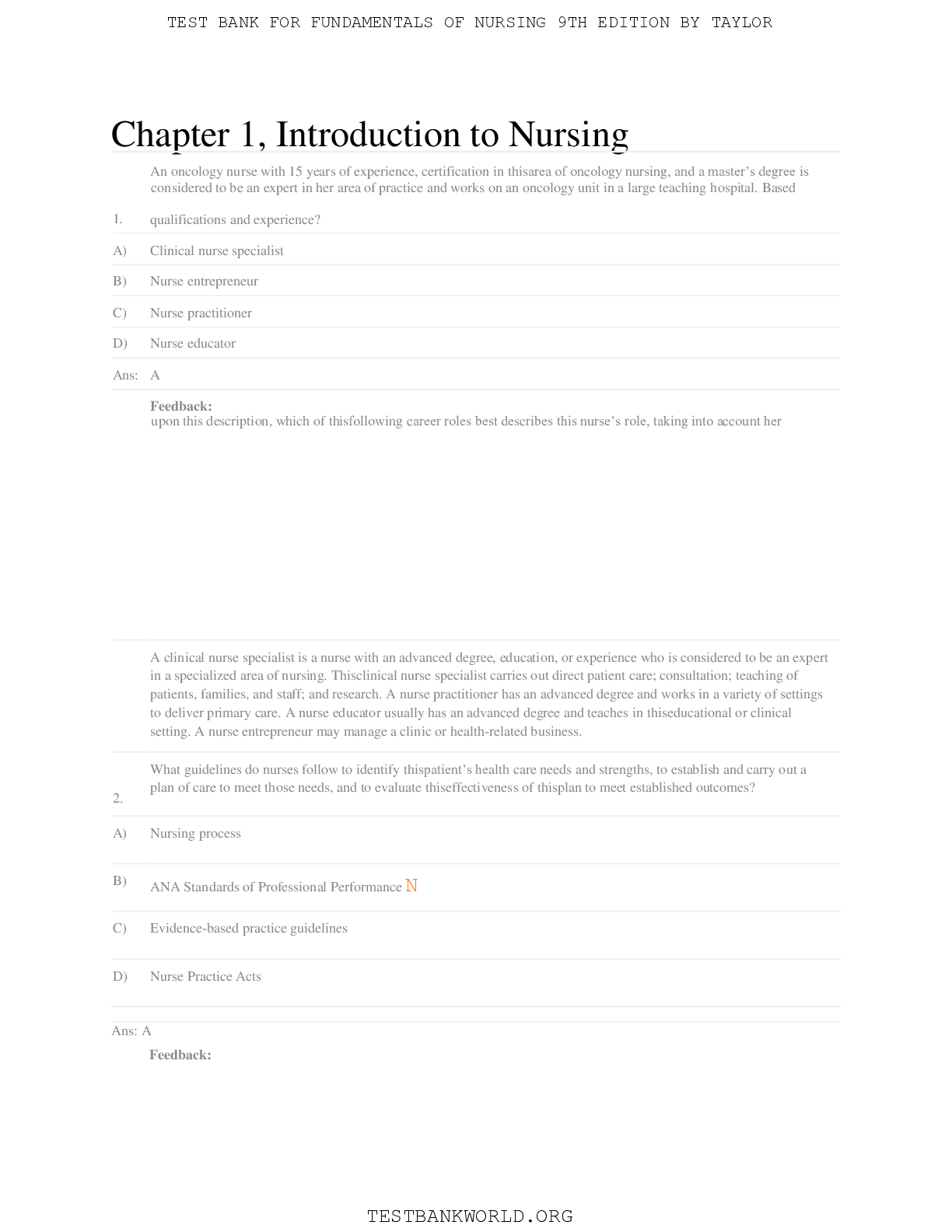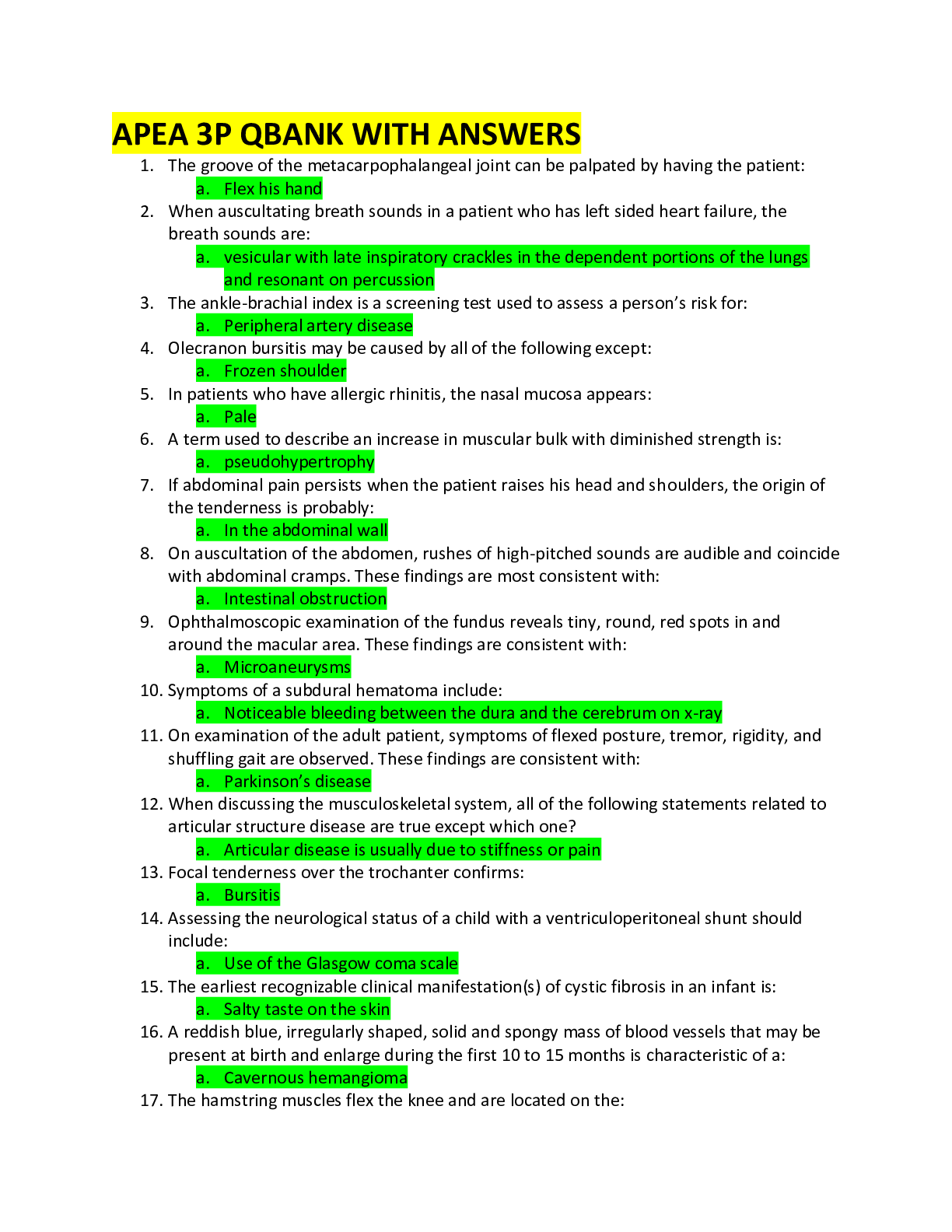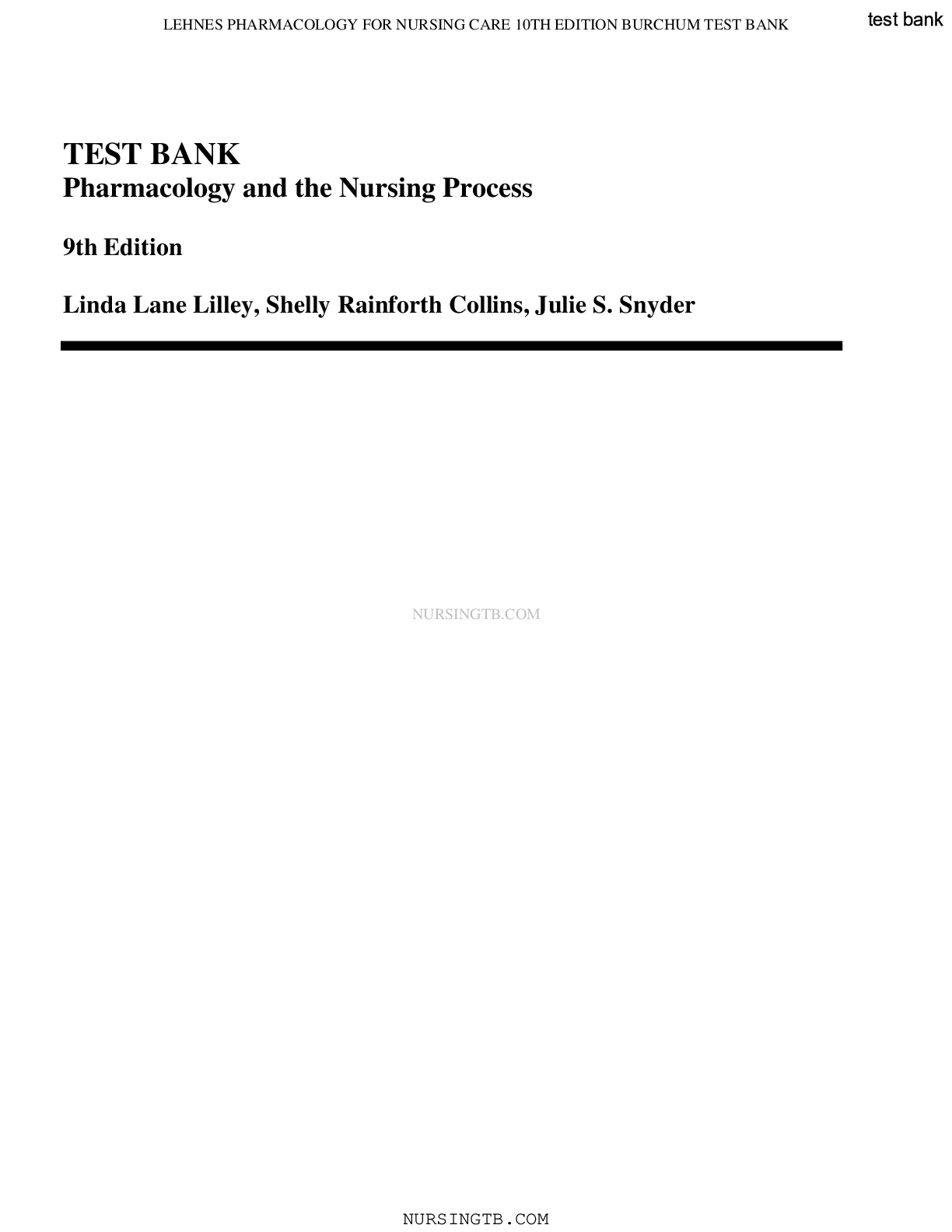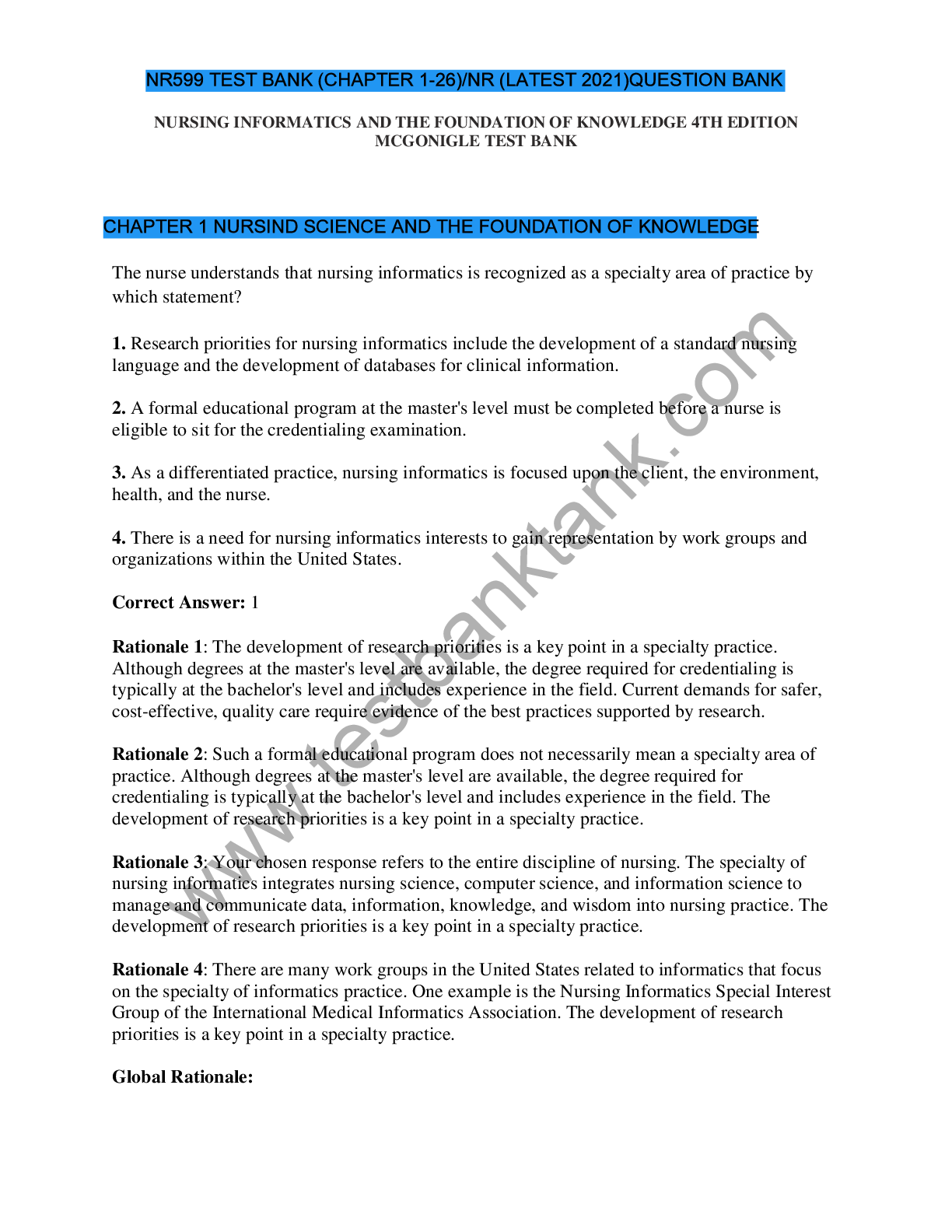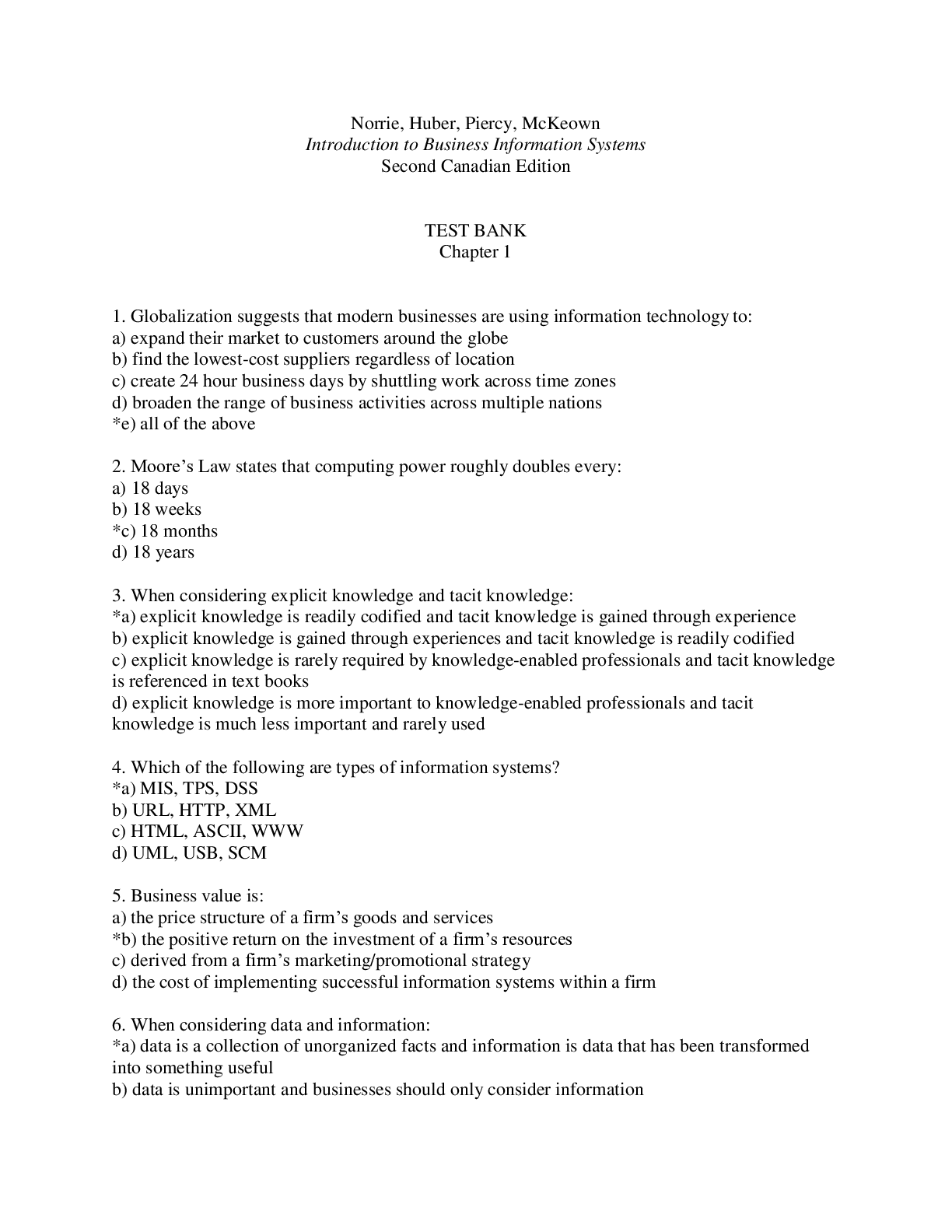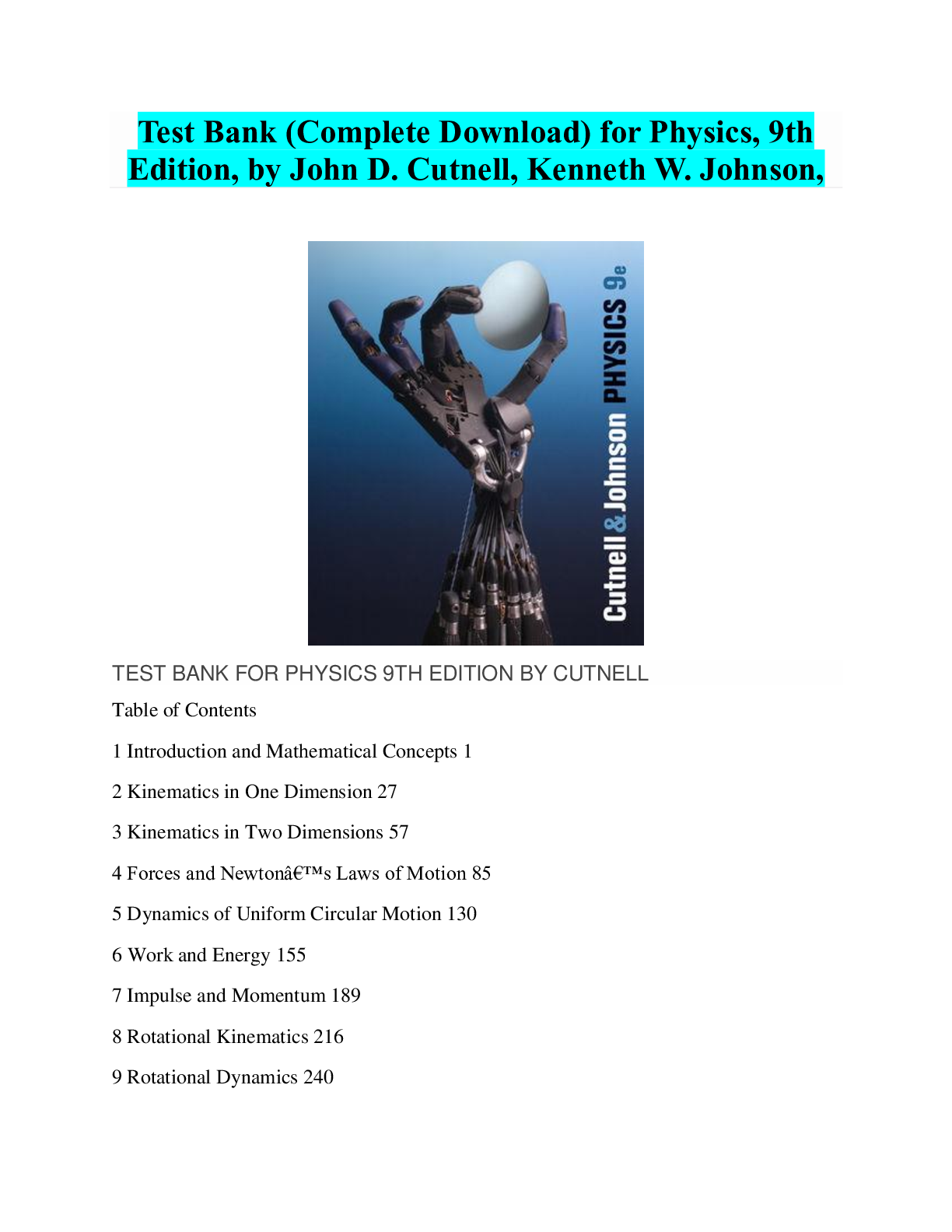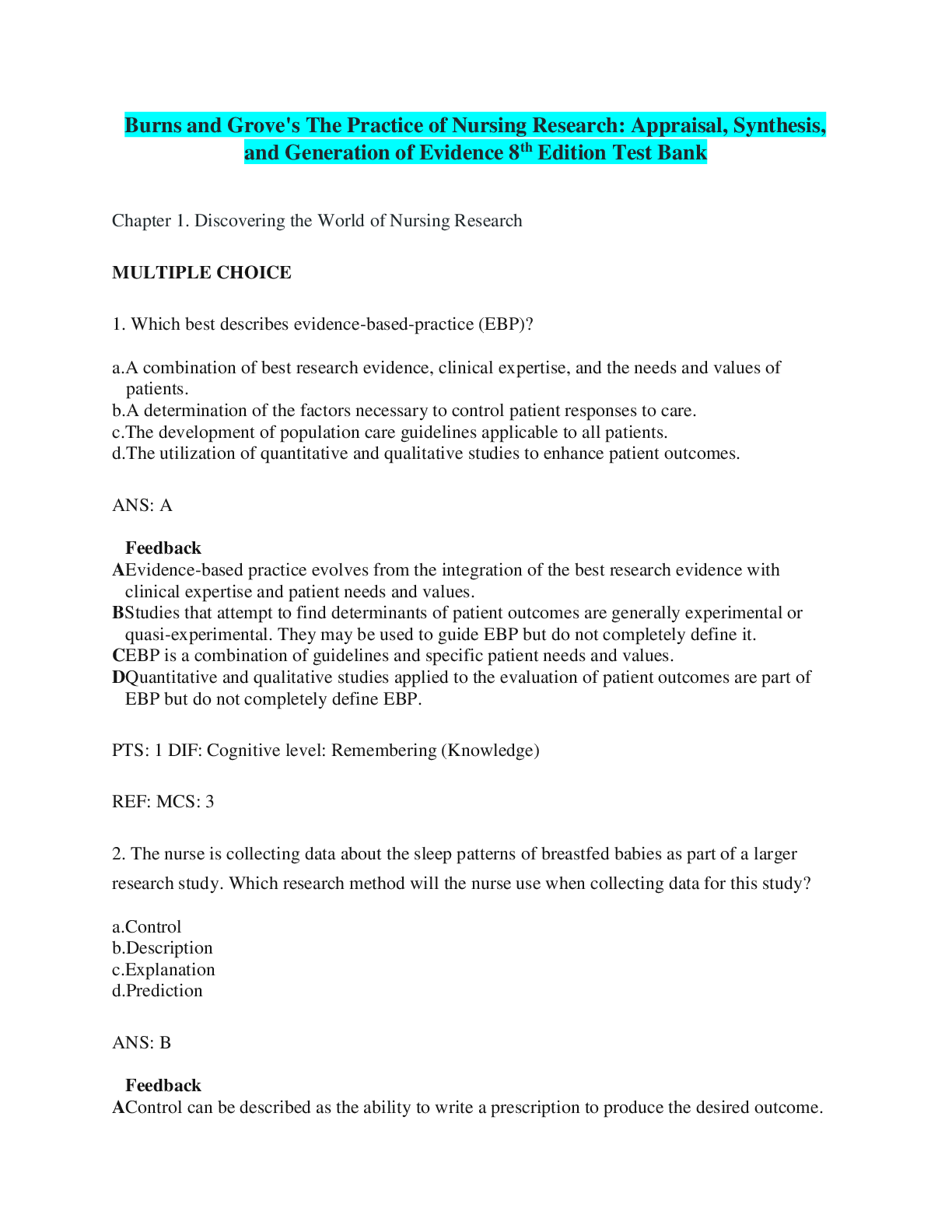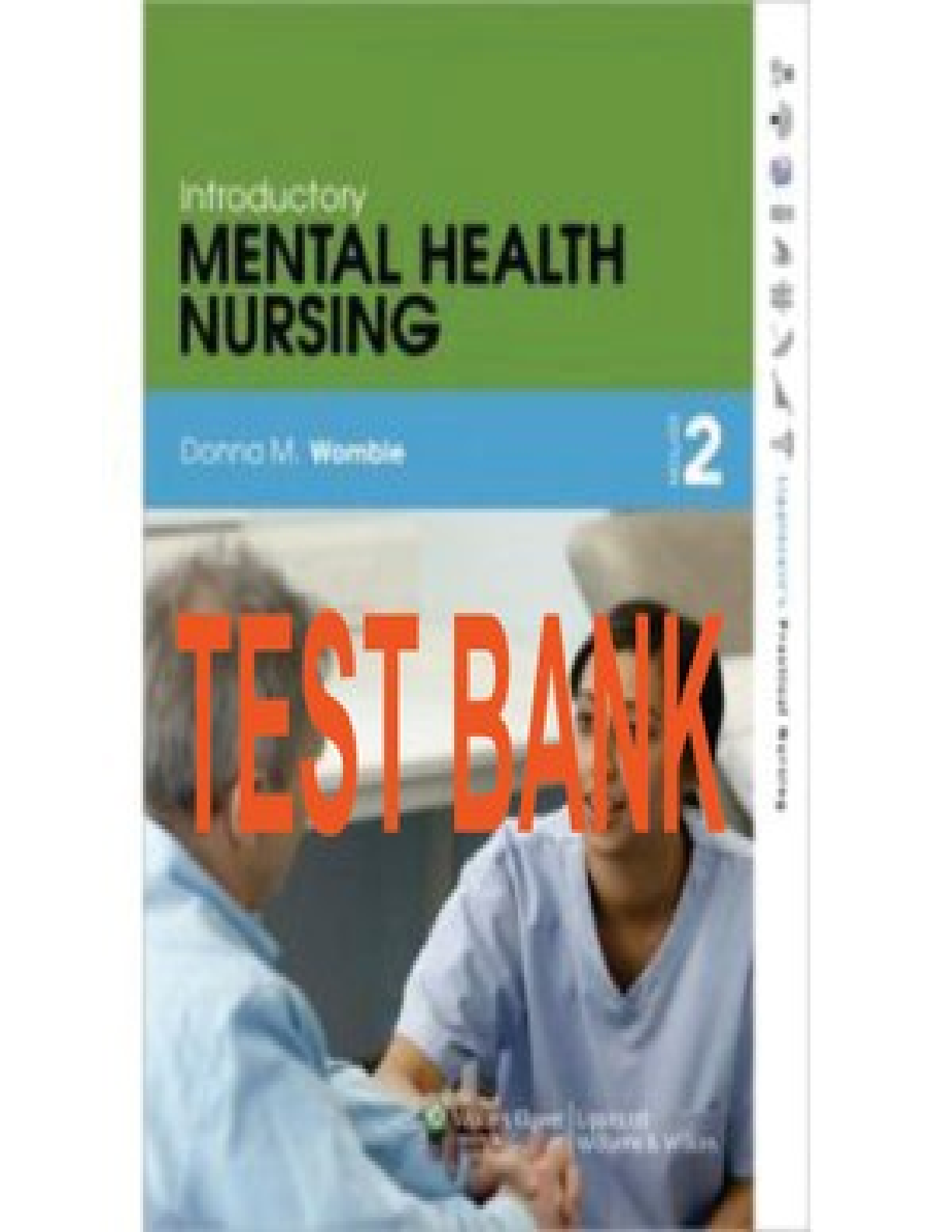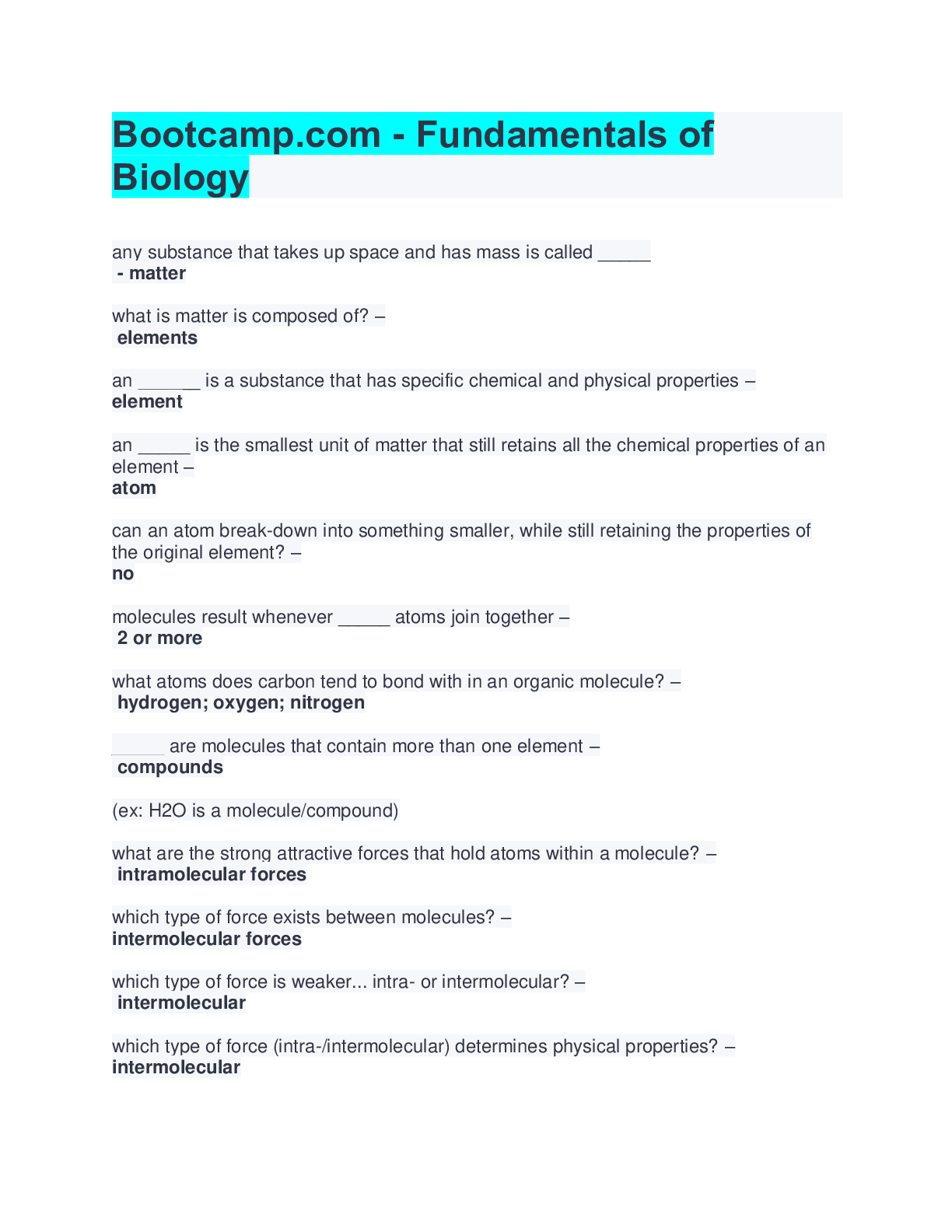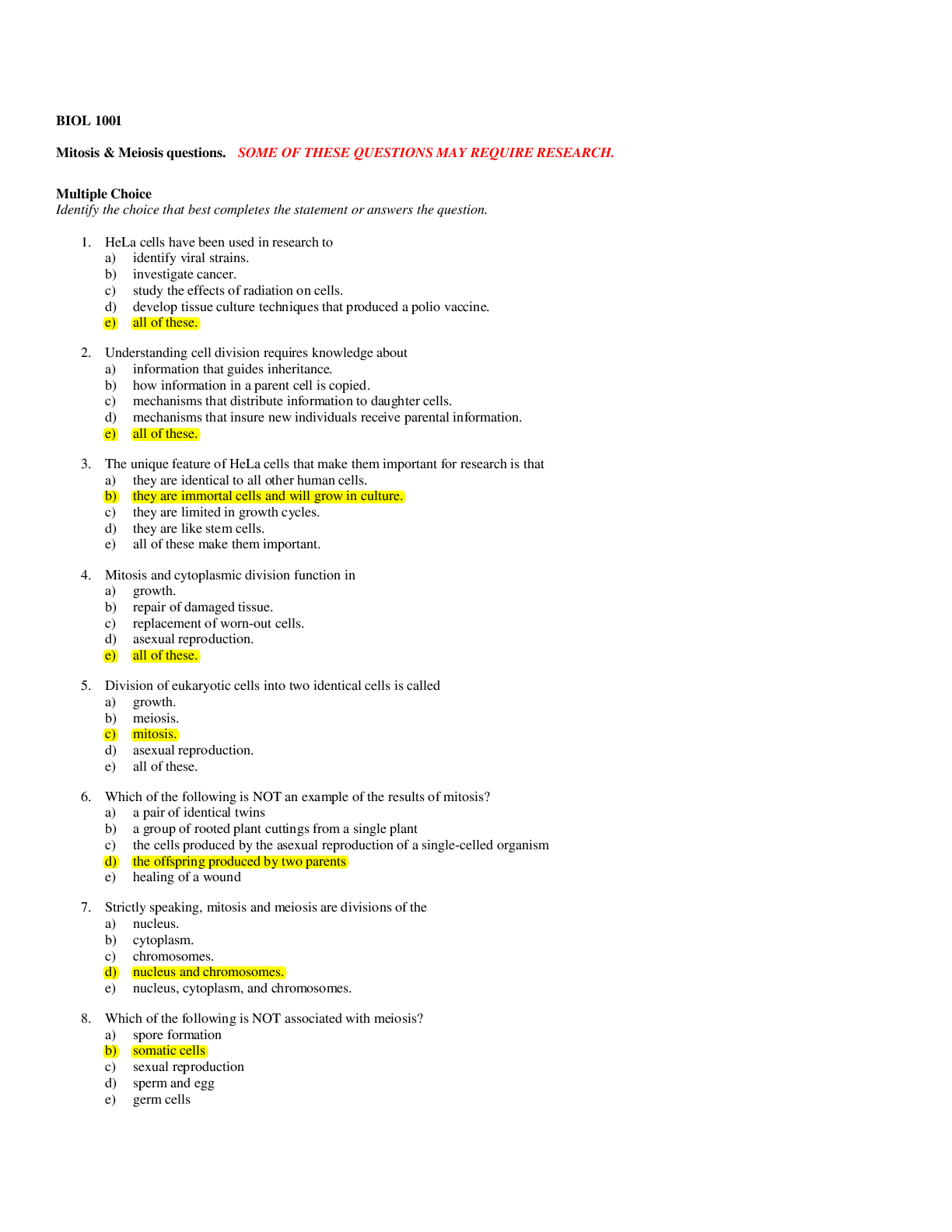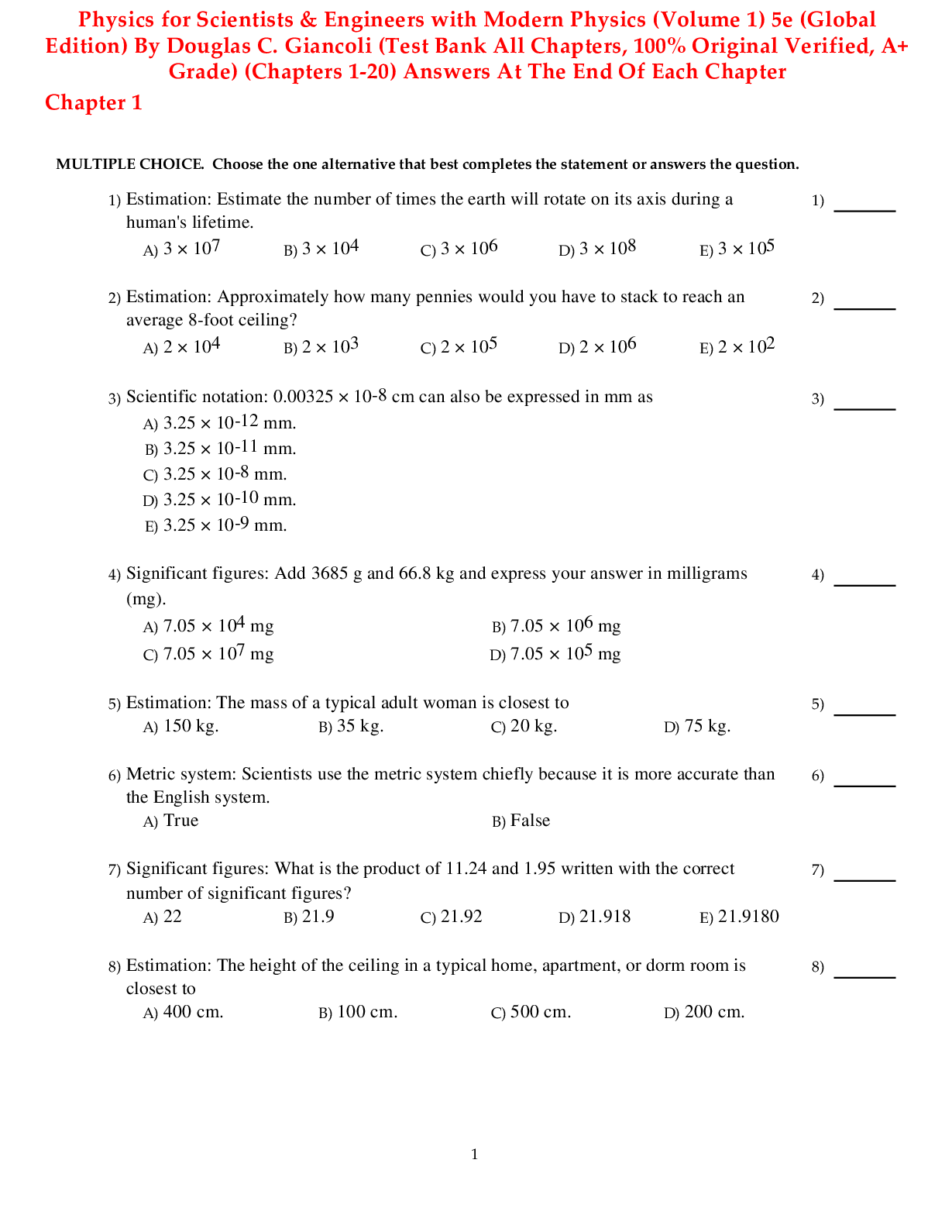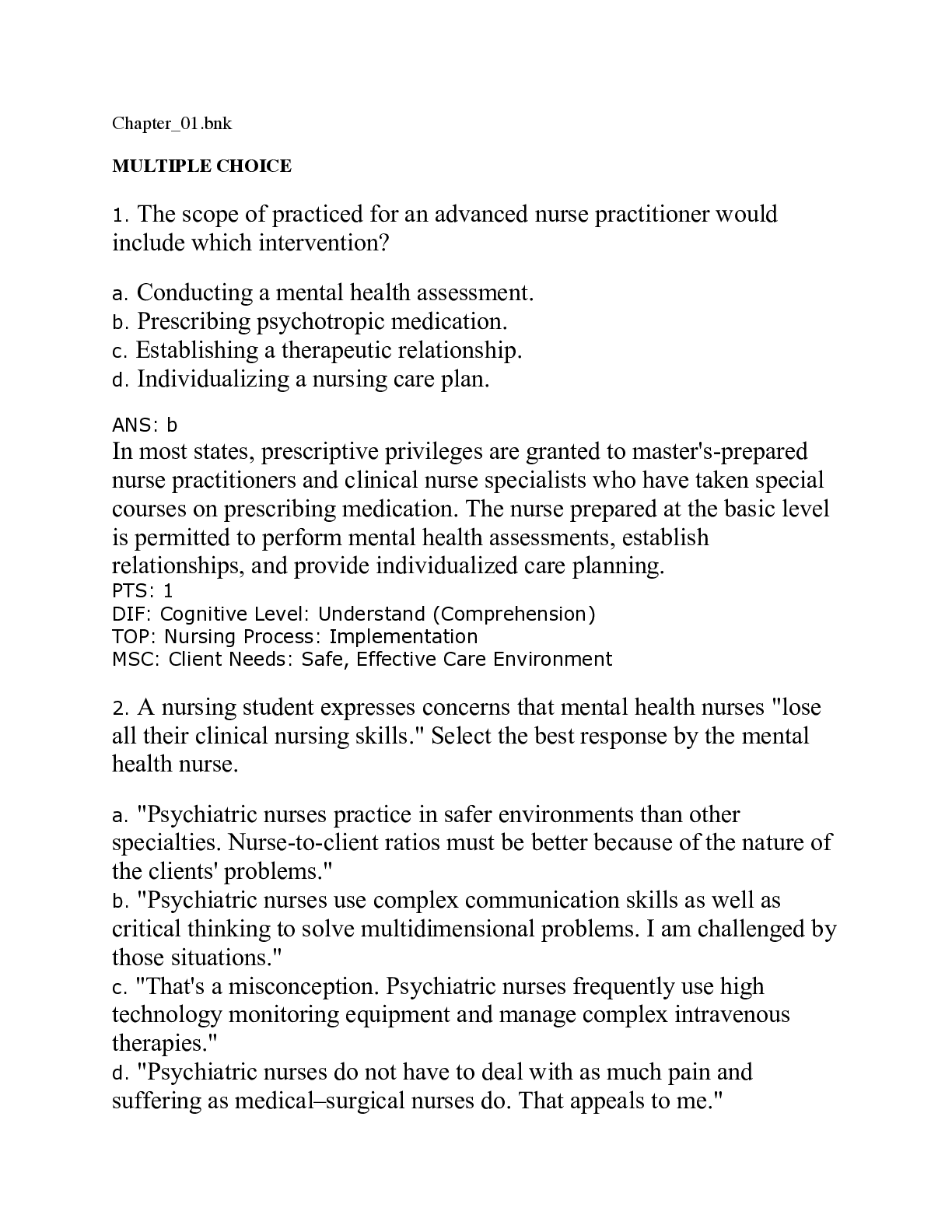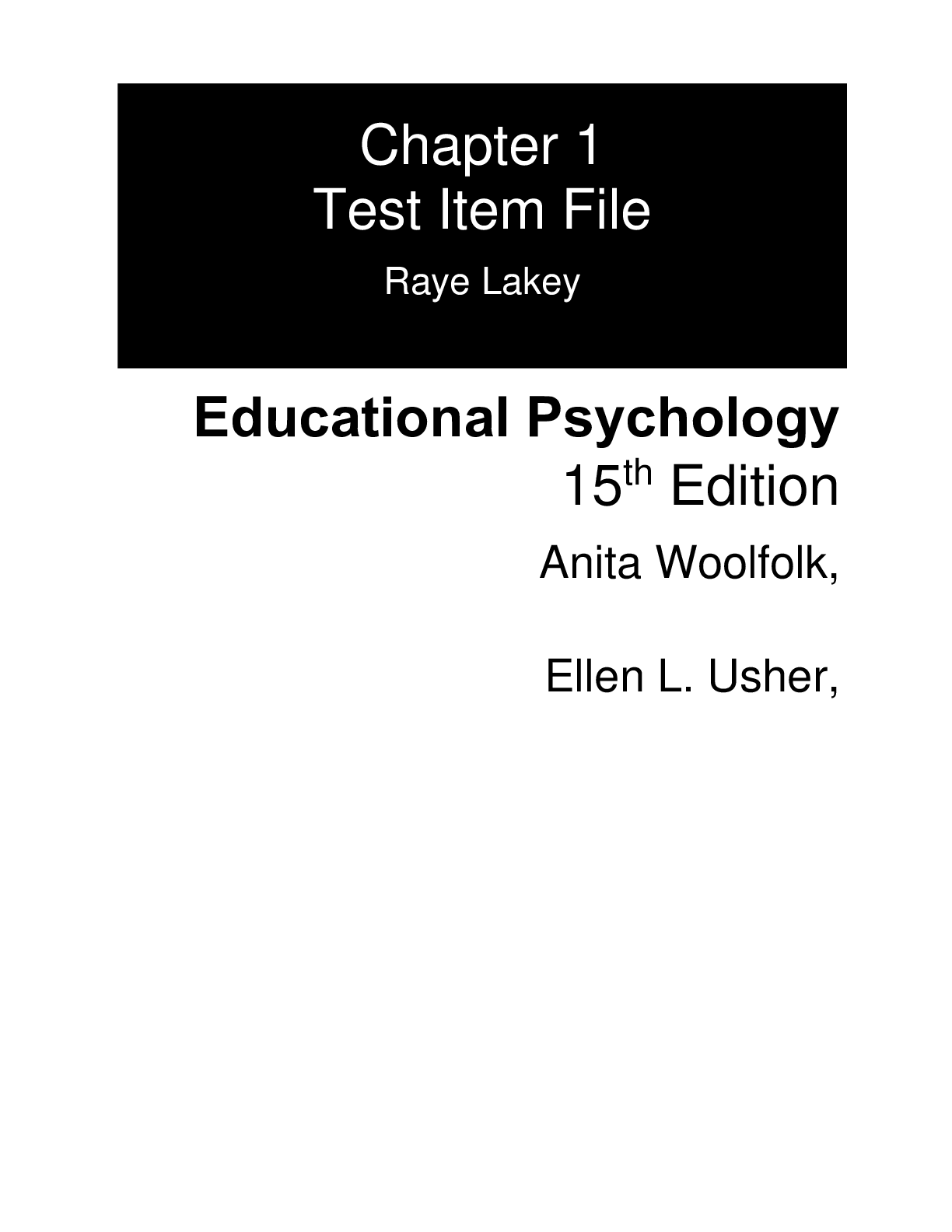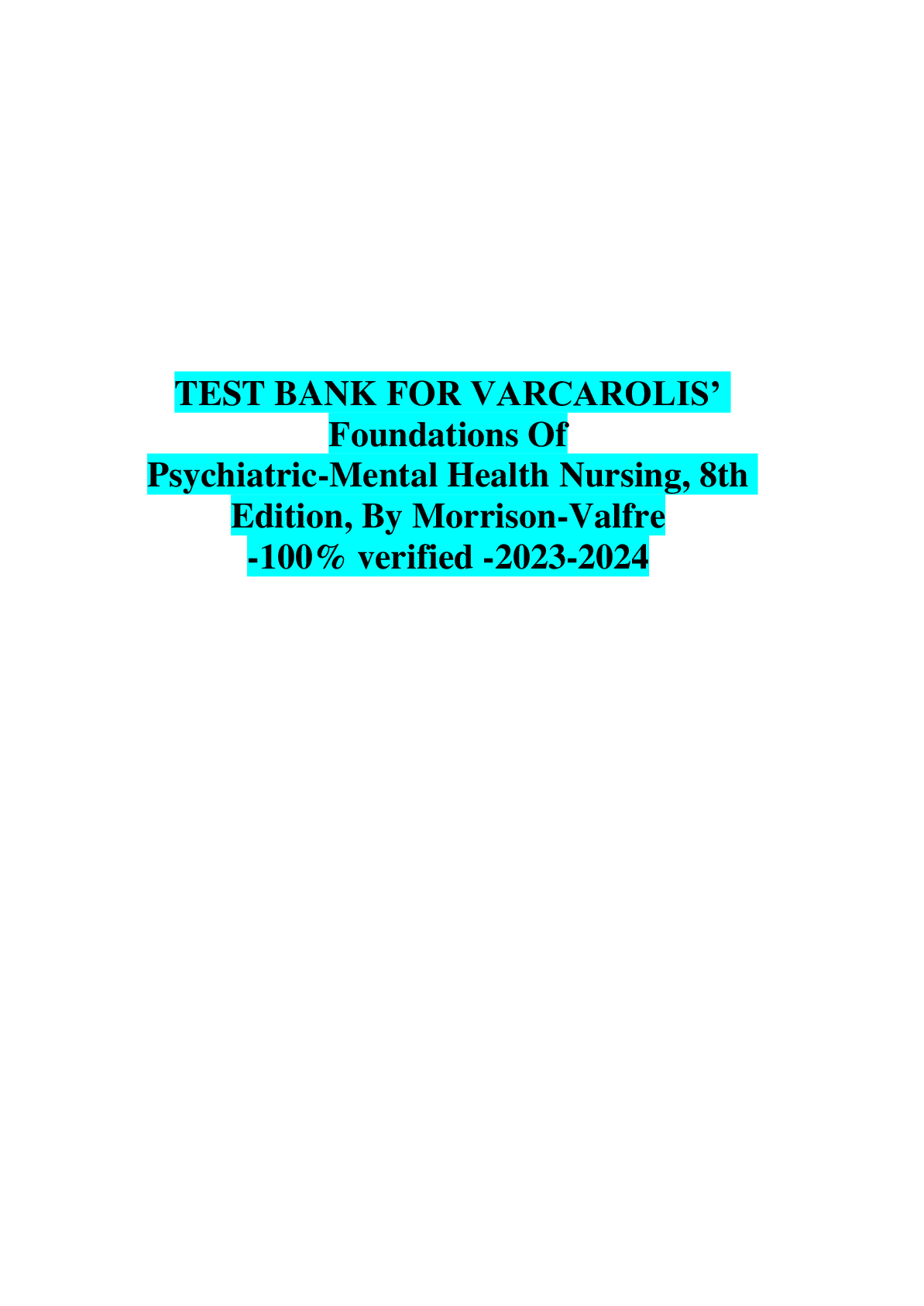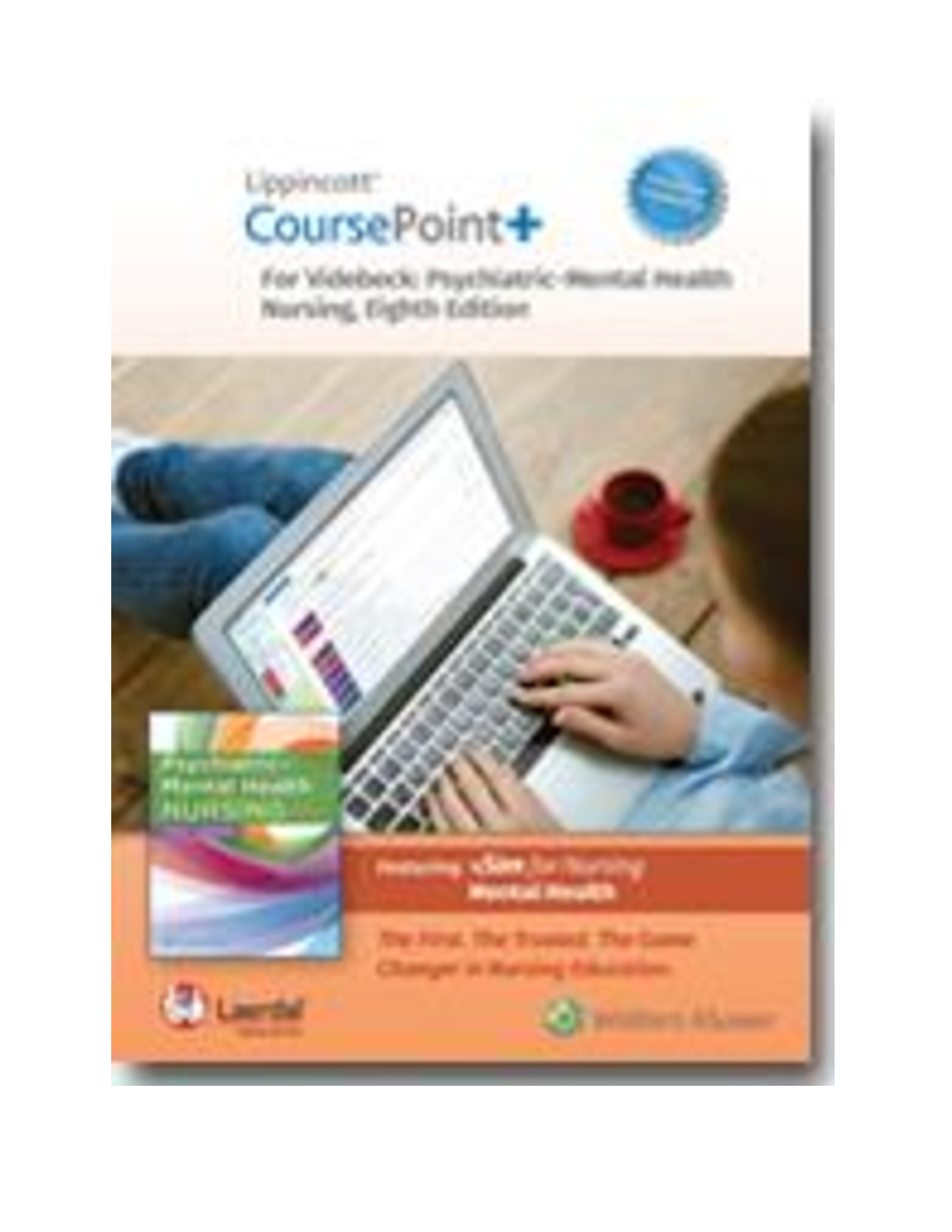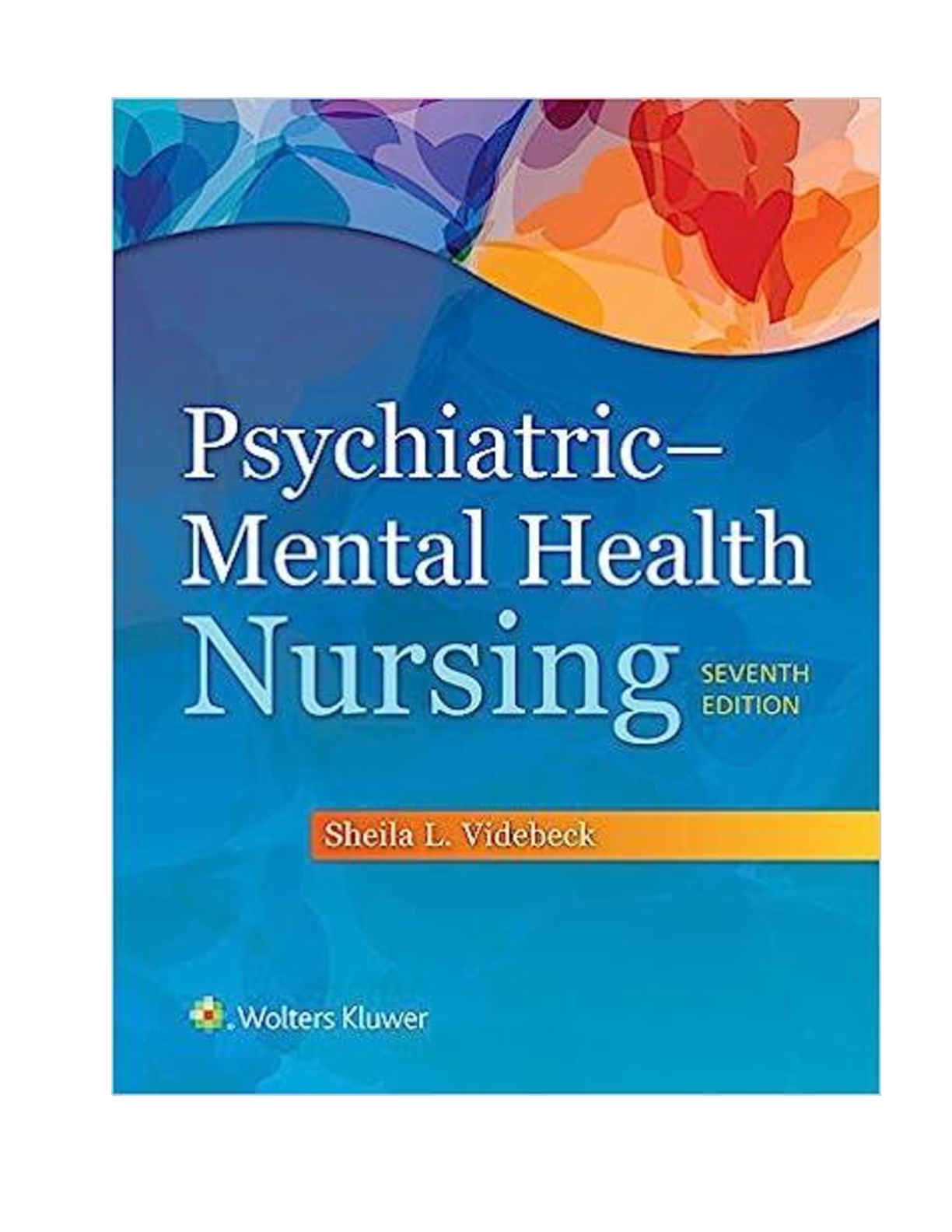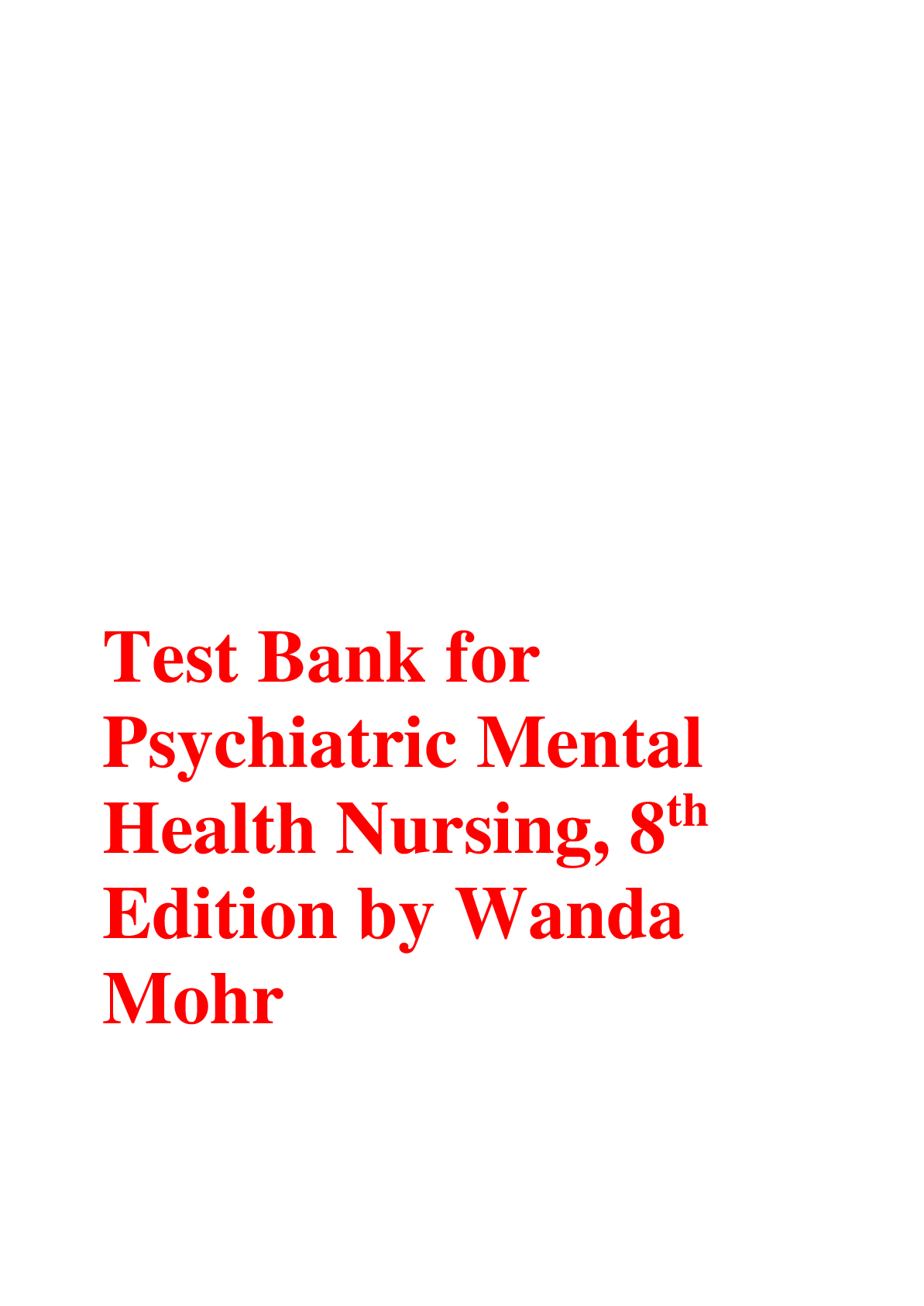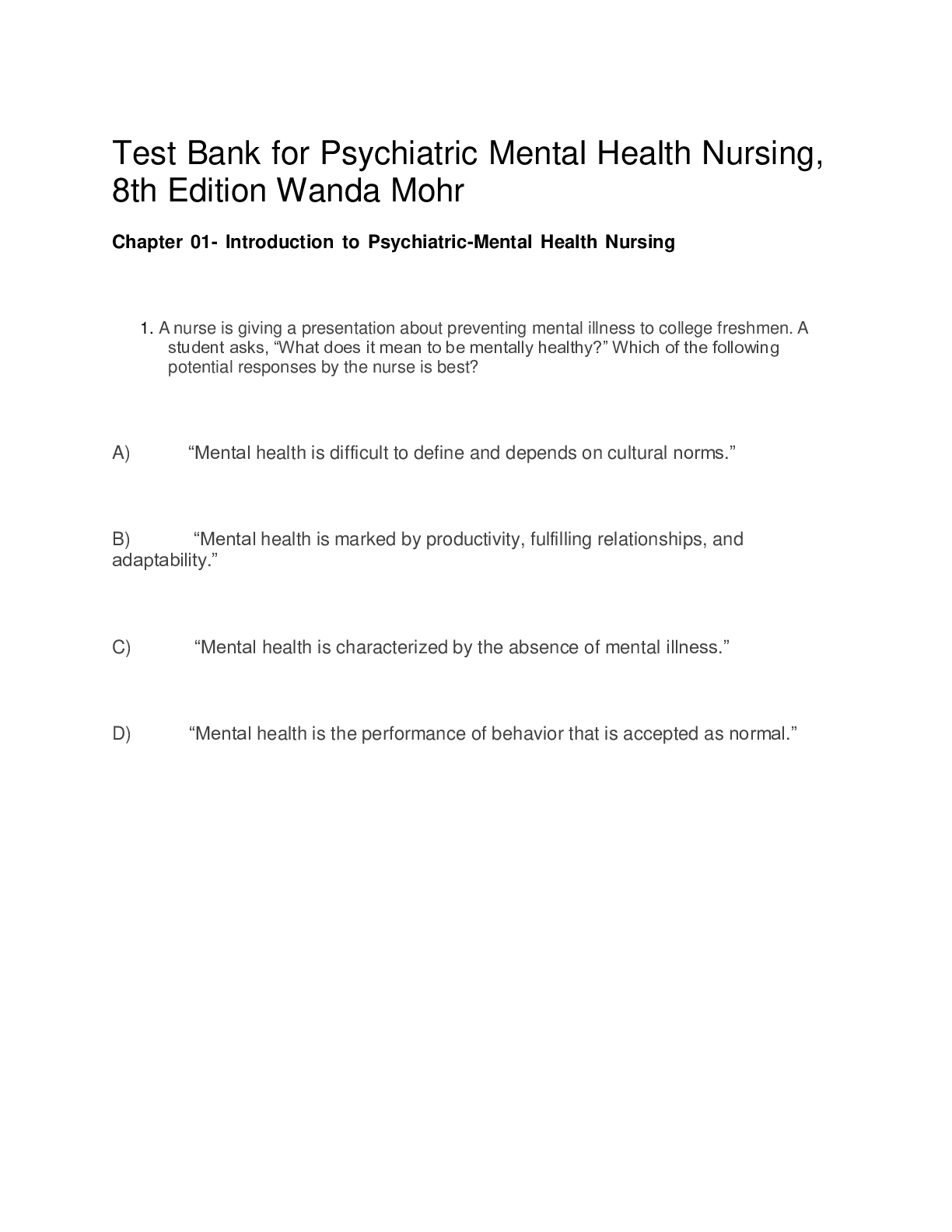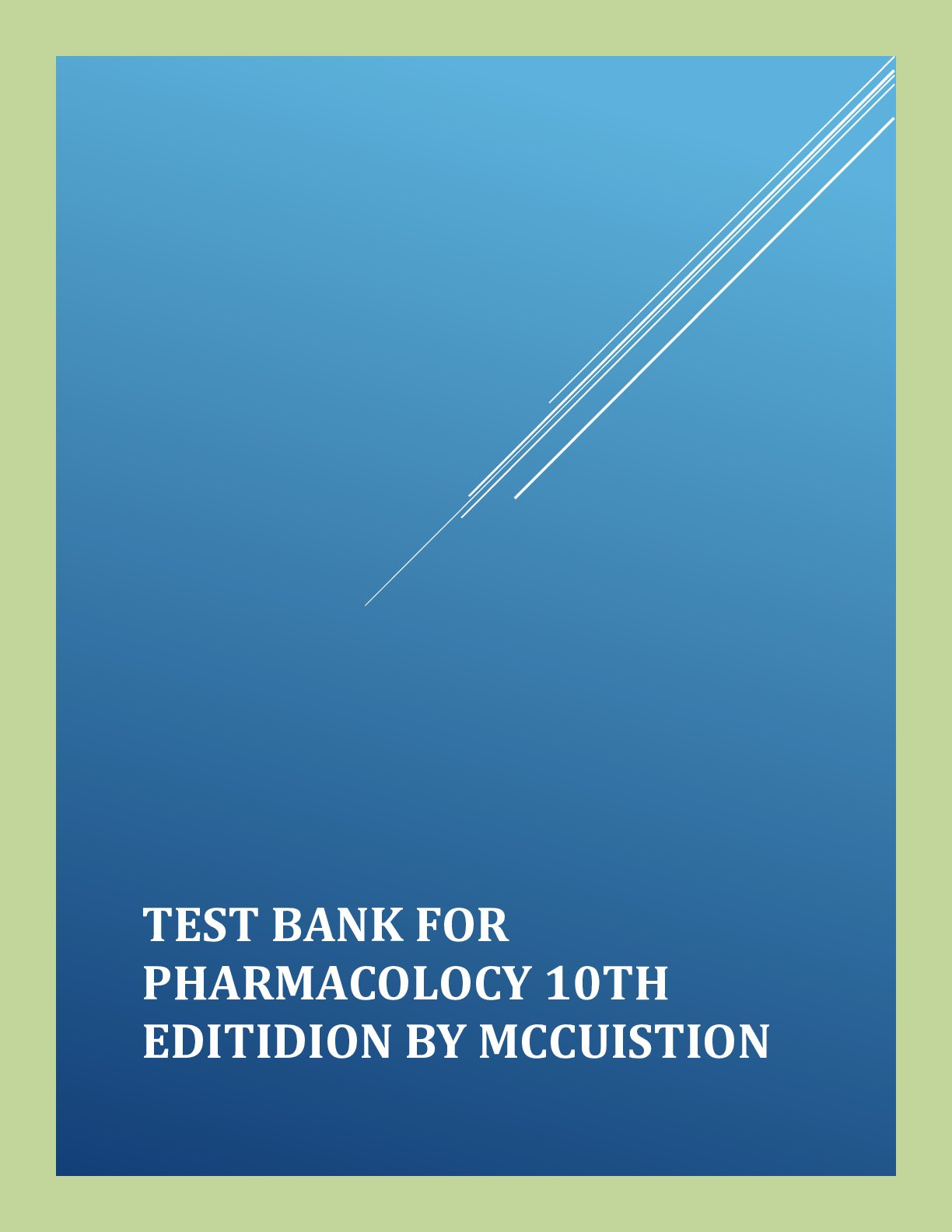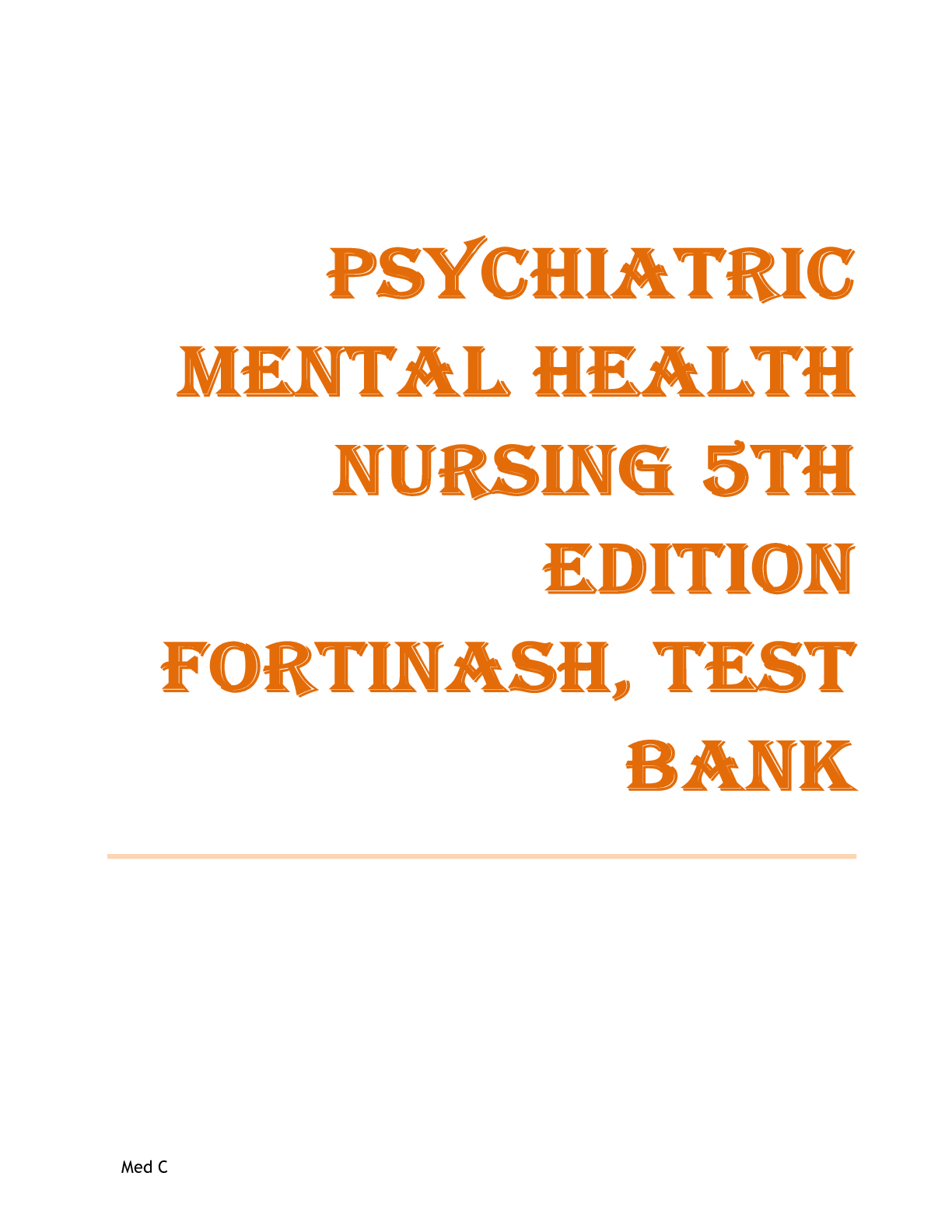*NURSING > TEST BANK > Fortinash: Psychiatric Mental Health Nursing, 5th Edition ( complete test bank, all chapters) (All)
Fortinash: Psychiatric Mental Health Nursing, 5th Edition ( complete test bank, all chapters)
Document Content and Description Below
Fortinash: Psychiatric Mental Health Nursing, 5th Edition Chapter 01: Psychiatric Nursing: Theory, Principles, and Trends 1. Which understanding is the basis for the nursing actions focused on... minimizing mental health promotion of families with chronically mentally ill members? a. Family members are at an increased risk for mental illness. b. The mental health care system is not prepared to deal with family crises. c. Family members are seldom prepared to cope with a chronically ill individual. d. The chronically mentally ill receive care best when delivered in a formal setting. ANS: A When families live with a dominant member who has a persistent and severe mental disorder the outcomes are often expressed as family members who are at increased risk for physical and mental illnesses. The remaining options are not necessarily true. DIF: Cognitive Level: Application REF: Page 3 2. Which nursing activity shows the nurse actively engaged in the primary prevention of mental disorders? a. Providing a patient, whose depression is well managed, with medication on time b. Making regular follow-up visits to a new mother at risk for post-partum depression c. Providing the family of a patient, diagnosed with depression, information on suicide prevention d. Assisting a patient who has obsessive compulsive tendencies prepare and practice for a job interview ANS: B Primary prevention helps to reduce the occurrence of mental disorders by staying involved with a patient. Providing medication and information on existing illnesses are examples of secondary prevention which helps to reduce the prevalence of mental disorders. Assisting a mentally ill patient with preparation for a job interview is tertiary prevention since it involves rehabilitation. DIF: Cognitive Level: Application REF: Page 4 3. Which intervention reflects attention being focused on the patient’s intentions regarding his diagnosis of severe depression? a. Being placed on suicide precautions b. Encouraging visits by his family members c. Receiving a combination of medications to address his emotional needs d. Being asked to decide where he will attend his prescribed therapy sessions ANS: D A primary factor in patient treatment includes consideration of the patient’s intentions regarding his or her own care. Patients are central to the process that determines their care as their abilities allow. Under the guidance of PMH nurses and other mental health personnel, patients are encouraged to make decisions and to actively engage in their own treatment plans to meet their needs. The remaining options are focused on specifics of the determined plan of care. DIF: Cognitive Level: Application REF: Page 5 4. When a patient’s family asks why their chronically mentally ill adult child is being discharged to a community-based living facility, the nurse responds: a. “It is a way to meet the need for social support.” b. “It is too expensive to keep stabilized patients in acute care settings.” c. “This type of facility will provide the specialized care that is needed.” d. “Being out in the community will help provide hope and purpose for living.” ANS: D Hospitalization may be necessary for acute care, but, when patients are stabilized, they move into community-based, patient-centered settings or are discharged home with continued outpatient treatment in the community. Concentrated efforts are made to reduce the patient’s sick role by providing opportunities for the development of a purposeful life and instilling hope for each patient’s future. Although social support is important, such a living arrangement is not the only way to achieve it. Although acute care is expensive, it is not the major concern when determining long-term care options. Community-based facilities are not the only option for specialized care. DIF: Cognitive Level: Application REF: Page 5 5. What is the best explanation to offer when the mother of a chronically ill teenage patient asks, “Under what circumstances would he be considered incompetent?” a. “When you can provide the court with enough evidence to show that he is not able to care for himself safely.” b. “It is not likely that someone his age would be determined to be incompetent regardless of his mental condition.” c. “He would have to engage in behavior that would result in harm to himself or to someone else; like you or his siblings.” d. “If the illness becomes so severe that his judgment is impaired to the point where the decisions he makes are harmful to himself or to others.” ANS: D When a person is unable to cognitively process information or to make decisions about his or her own welfare, the person may be determined to be mentally incompetent. Providing self-care is not the only criteria considered. Age is not a factor considered. The decision is often based on the potential for such behavior. DIF: Cognitive Level: Application REF: Page 6 6. Which psychiatric nursing intervention shows an understanding of integrated care? a. A chronically abused woman is assessed for anxiety. b. A manic patient is taken to the gym to use the exercise equipment. c. The older adult diagnosed with depression is monitored for suicidal ideations. d. A teenager who refuses to obey the unit’s rules is not allow to play video games. ANS: A The majority of health disciplines now recognize that mental disorders and physical illnesses are closely linked. The presence of a mental disorder increases the risk for the development of physical illnesses and vice versa. Assessing a chronically abused individual for anxiety call should attention to the psychiatric disorder that could develop from the abuse. The remaining options show interventions that are appropriate for the mental disorder. DIF: Cognitive Level: Application REF: Page 6 7. What reason does the nurse give the patient for the emphasis and attention being paid to the recovery phase of their treatment plan? a. Recovery care, even when intensive, is less expensive than acute psychiatric care. b. Effective recovery care is likely to result in fewer relapses and subsequent hospitalizations. c. Planning for recovery care is time consuming and involves dealing with many complicated details. d. Recovery care is usually done on an outpatient basis and so is generally better accepted by patients. ANS: B Much attention is paid to recovery care since effective recovery care helps improve patient outcomes and thus minimize subsequent hospitalizations. Recovery care is not necessarily less expensive than acute care. Although effective recovery care planning may be time consuming and detail oriented, that is not the reason for implementing it. Recovery care is not necessarily well accepted by patients. DIF: Cognitive Level: Application REF: Page 7 8. The nurse is attending a neighborhood meeting where a half-way house is being proposed for the neighborhood when a member of the community states, “We don’t want the facility; we especially don’t want violent people living near us.” The response by the nurse that best addresses the public’s concern is: a. “In truth, most individuals with psychiatric disorder are passive and withdrawn and pose little threat to those around them.” b. “The mentally ill seldom behave in the manner they are portrayed by movies; they are people just like the rest of us.” c. “Patients with psychiatric disorder are so well medicated that they do not display violent behaviors.” d. “The mentally ill deserve a safe, comfortable place to live among people who truly care for them.” ANS: A A major reason for the existence of the stigma placed on persons with mental illness is lack of knowledge. The main fear is of violence, although only a small percentage of patients with mental illness display this behavior. Providing the public with accurate information can help reduce stigma. The remaining options do not directly address the concerns stated. DIF: Cognitive Level: Application REF: Pages 13-14 9. Which activity shows that a therapeutic alliance has been established between the nurse and patient? a. The nurse respects the patient’s right to privacy when visitors are spending time with the patient. b. The patient is eagerly attending all group sessions and working independently on identifying their personal stressors. c. The patient is freely describing their feelings related to the physical and emotional trauma they experienced as a child with the nurse. d. The nurse dutifully administers the patient’s medications on time and with appropriate knowledge of the potential side effects. ANS: C A primary aspect of working with patients in any setting and particularly in the psychiatric setting is the development of a therapeutic alliance with the patient. Such an alliance is established on trust. It is a professional bond between the nurse and the patient that serves as a vehicle for patients to freely discuss their needs and problems in the absence of the nurse’s criticism or judgment. Any nurse has an obligation to respect the patient’s rights and administer care effectively. The patient’s willingness to participate in the plan of care reflects self motivation. DIF: Cognitive Level: Application REF: Page 9 10. Mental health care reform has called for parity between psychiatric and medical diagnoses. Which is an example of such parity? a. Depression treatment is not paid for as readily as is treatment for asthma. b. The mentally ill patient will be protected by law against social stigma. c. Medical practitioners are trained to be proficient at treating mental disorders. d. Psychiatric service reimbursement will be equivalent to that of medical services. ANS: D The term parity as used here refers to payments for mental health services that equal payment schedules for medical or surgical conditions. The remaining options(B and C) do not relate to financial reimbursement or funds allocated for mental health care being equal to those of medical diagnoses. DIF: Cognitive Level: Application REF: Page 15 1. Which assessment findings suggest to the nurse that this patient has characteristics seen in an individual who has reached self-actualization? Select all that apply. a. Reports to have, “found peace and security in my religious faith” b. Effectively “changed occupations” when a chronic vision problem worsened c. Has consistently earned a six-figure salary as an architect for the last 10 years d. Has been in a supportive, loving relationship with the same individual for 15 years e. Provides free literacy tutoring help at the local homeless shelter 3 evenings a week ANS: A, B, D, E Characteristics of self actualization would include: spiritual well-being, open and flexible, relationally fulfilled, and generosity toward others. Salary doesn’t necessarily reflect self-actualization. DIF: Cognitive Level: Application REF: Page 4 2. Which nursing activities represent the tertiary level of mental health care? Select all that apply. a. Providing a depression screening at a local college b. Helping a mental-challenged patient learn to make correct change c. Reporting an incidence of possible elder abuse to the appropriate legal agency d. Regularly assessing a patient’s understanding of their prescribed antidepressants e. Providing a 6-week parenting class to teenage parents through a local high school ANS: B, D Tertiary prevention reduces the residual effects of the disorder such as depression and mental retardation. There is no quaternary level of prevention. Primary prevention reduces occurrences of mental disorders such as screenings and parenting classes, and secondary prevention reduces the prevalence of disorders as evidenced by assessing knowledge. DIF: Cognitive Level: Application REF: Page 4 3. Which nursing actions indicate an understanding of the priority issues currently facing psychiatric mental health nursing today? Select all that apply. a. Working on the facility’s ‘Safe Use of Restraints Policy’ revision committee b. Advocating for increased salaries for all levels of psychiatric mental health nurses c. Attending a political rally for increased state funding for mental health service providers d. Offering an in-service to facility staff regarding the cultural implications of caring for the Hispanic patient e. Joining the state nursing committee working on the role and scope of practice of the advanced practice psychiatric nurse ANS: A, C, D, E Priority issues include funding, safety issues in psychiatric treatment centers—particularly the use of patient restraints, quality-of-care issues, access to health care for minority populations, and standardization of advanced practice nurse roles. DIF: Cognitive Level: Application REF: Page 9 4. Which assessment findings describe risk factors that increase the potential risk for mental illness? Select all that apply. a. Possesses high tolerance for stress b. Is very curious about ‘how things work’ c. Admits to being a member of an ethnic gang d. Only practicing Jew among school classmates e. Has a younger sibling who is mentally challenged ANS: C, D, E Risk factors are internal predisposing characteristics and external influences that increase a person’s vulnerability and potential for developing mental disorders. Types of risk factors and examples include the following: having a mentally-challenged family member in the home; belonging to a punitive gang; and being the object of reject or bullying. The remaining options are protective factors. DIF: Cognitive Level: Application REF: Page 11 5. Which nursing actions show a focus on the fundamental goals that guide psychiatric mental health nurses in providing patient care? Select all that apply. a. Offering an informational session of identifying signs of depression at a local senior center b. Attending a workshop on evidence practice interventions for the chronically depressed patient c. Keeping strict but appropriate boundaries with a patient diagnosed with a personality disorder d. Asking a parent who has just experienced the death of a child if they could consider talking with a grief counselor e. Identifying what help a patient diagnosed with Alzheimer’s disease will need with instrumental activities of daily living (IADLs) ANS: A, B, D, E Standard objectives guide PMH nurses and members of related disciplines in the care of patients (individuals, families, communities, and organizations). The objectives and criteria are as follows: the promotion and protection of mental health, the prevention of mental disorders, the treatment of mental disorders, and recovery and rehabilitation. Keeping appropriate boundaries is a generalized nursing responsibility. DIF: Cognitive Level: Analysis REF: Page 3 Chapter 02: Nursing Practice in the Clinical Setting 1. Which nursing action is a reflection of Hildegard Peplau’s theoretic framework regarding psychiatric mental health nursing? a. Basing patient outcomes on expected instinctual responses b. Discussing a patient’s feelings regarding parents and siblings c. Providing the patient with clean clothes and wholesome food d. Centering professional practice in a state run psychiatric facility ANS: B Peplau’s pioneering endeavors and contributions were largely influenced by interpersonal psychotherapy. She believed that disorders evolved in the social context of interpersonal interactions. (i.e., what went on between people). Instinctual responses are more related to intrapersonal interactions. Florence Nightingale was instrumental in the holistic approach to nursing care, whereas Linda Richards’ practice was centered on institutional care of the mental ill. DIF: Cognitive Level: Application REF: Page 18 2. The nurse is attempting to provide a safe environment for a patient at great risk for self-harm. Which intervention shows an understanding of evidence-based practice (EBP)? a. Using physical restraints only after all other options have been proven ineffective b. Referring to the facility’s policies manual for guidelines for applying physical restraints c. Collecting data regarding the short-term effects of using physical restraints on an aggressive patient d. Requiring constant monitoring of a patient whose inability to self-regulate anger has required the use of physical restraints ANS: B Health care systems are participating in the shift in nursing practice by encouraging research in their facilities and by implementing interventions that increase nurses’ knowledge about EBP. Nurses are participating to make evidence-based nursing practices available for their use, and they are helping to determine the outcomes that will benefit patients. The remaining options are examples of long-standing practice related to the use of physical restraints. DIF: Cognitive Level: Application REF: Page 19 3. Which statement by the patient reflects patient education that was based on the concept of integrated patient care? a. “I know I’m anxious when I get a tension headache.” b. “My anxiety is a result of stressors I don’t cope well with.” c. “Medication has helped me tremendously with anxiety control.” d. “Anxiety runs in my family; my entire family is trying to deal with it.” ANS: A Integrated patient care is the recognition of the interplay between physical and mental health. In integrated care, these disorders are not treated as separate illnesses; rather, they are treated together. The remaining options make no mention of a relationship between mental and physical illness. DIF: Cognitive Level: Application REF: Page 19 4. The nurse demonstrates objective patient care when: a. Being sympathetic to the patient’s recent loss of a spouse b. Protecting the anxious patient by eliminating stressors in the milieu c. Responding to the patient by stating, “I know exactly how you feel.” d. Facilitating the patient’s exploration of various stress reduction techniques ANS: D The nurse demonstrates objectivity by helping the patient to process and organize thoughts that are directed toward the solving of his or her own problems. With sympathy, the nurse loses objectivity and moves into his or her own personal feelings. Removing all stress does not allow the patient to develop necessary coping skills. DIF: Cognitive Level: Application REF: Pages 21- 22 5. Which nursing intervention would be appropriately addressed during the orientation phase of the nurse–patient relationship? a. Self reflection by the nurse regarding personal biases and prejudices regarding the patient b. Patient works at prioritizing personal needs and develops realistic expected outcomes c. Establishing the contract between the nurse and the patient regarding mutual needs and expectations d. Patient commits to the reinforcement of positive personal characteristics while working on problems and concerns ANS: C A contract or agreement is established during the orientation phase of the relationship. The contract defines limits and expectations of both the patient and the nurse. Self Reflection occurs during the pre-orientation phase while the remaining options are addressed during the working phase of the relationship. DIF: Cognitive Level: Analysis REF: Page 22 6. Which action on the part of a novice psychiatric mental health nurse shows a need for future development of altruism? a. Excusing a patient from attending group because, “all that talking makes me so anxious” b. Not permitting two patients who are physically attracted to each other to engage in public displays of affection c. Placing a physically aggressive patient in restraints when they are unable to internally calm their anger d. Self-reflecting on “why I continue to work with patients who are so emotionally damaged they will never be normal” ANS: A This option shows a misguided kindness that will ultimately have a negative impact on the patient’s treatment. The remaining options show responsible nursing interventions that include self-reflection of personal motivation for such work. DIF: Cognitive Level: Application REF: Page 24 7. The greatest negative outcome resulting from a nurse’s fear of a mentally ill patient is that the: a. Nurse will reinforce negative stereotyping of the mentally ill. b. Patient will experience increased bias against the nursing staff. c. Public’s fearfulness of the mentally ill will continue to be exaggerated. d. Therapeutic alliance between the nurse and patient will not develop effectively. ANS: D Unrealistic preconceived images, stereotyping, and biases have an effect on nurses that, when resulting in fear, will negatively impact the therapeutic effectiveness of the nurse and the care provided. The remaining options do not have the priority that providing quality patient care has. DIF: Cognitive Level: Application REF: Page 26 8. Which action on the part of a novice mental health nurse will best minimize fear related to effectively working with the psychotic patient? a. Be knowledgeable about psychotropic medications and their affect on psychosis. b. Always arrange for staff support when working one-on-one with a psychotic patient. c. Take advantage of opportunities to attend workshops devoted to the care of the psychotic patient. d. Recognize that the psychotic patient is not in control of their behaviors due to their altered though processes. ANS: C Fear breeds avoidance, but knowledge and preparation diminish fear and bring confidence. Being prepared before entering the psychiatric setting includes having knowledge and understanding of mental disorders. The remaining options do not provide confidence but rather means of controlling or avoiding the psychotic patient. DIF: Cognitive Level: Analysis REF: Page 26 9. Which response by the nurse manager to a novice mental health nurse is most effective when the nurse asks, “How do I justify not keeping a patient’s secret?” a. “Never promise the patient that you will keep a secret for them.” b. “Always stop the patient from telling you something as a secret.” c. “Let the patient know that you will not keep a secret that could ultimately cause harm or affect their treatment.” d. “Keep reminding yourself that you are not the patient’s friend but rather a professional mental health provider.” ANS: C Nurses and other healthcare professionals do not keep secrets or make promises to patients when the secret may interfere with the patient’s treatment or put them or others at risk for harm. The remaining options offer appropriate nursing actions but do not effectively answer the nurse’s question. DIF: Cognitive Level: Analysis REF: Page 30 10. The nurse is effectively facilitating the nurse-patient relationship when: a. Sharing with an angry patient who is verbally abusive that, “Although I can accept that you are angry, I cannot and will not accept your verbal abuse.” b. Focusing on the patient’s life experience without relating to the similarities of one’s own experiences c. Objectively providing constructive criticism that is directed to helping the patient identify inappropriate behaviors d. Refraining from abandoning the patient regardless of the frustration the interaction causes ANS: A Accepting the patient’s feelings is essential; however, it is not necessary to accept all of the patient’s behaviors. Assist the patient by setting limits on patient behaviors that are self-defeating or that threaten the patient or others in any way. Setting these limits allows for mutual respect in the therapeutic alliance. The remaining options enhance the patient’s clinical experience rather than the nurse-patient relationship. DIF: Cognitive Level: Application REF: Page 35 11. An often expressed intrinsic reward of psychiatric mental health nursing is: a. Seeing the seriously ill recover their health b. Working with patients of all ages and walks of life c. Working with well-trained, caring health care providers d. Having time to really focus on the human who is the patient ANS: D Psychiatric mental health nurses are able to spend the time to know the patient not only as a patient but as an individual. This is an opportunity most nurses whose practice is based on the physical care of the patient is not afforded. The remaining options are not necessarily unique to psychiatric nursing. DIF: Cognitive Level: Application REF: Page 36 12. Which statement is an example of an inference? a. “He is an alcoholic because his wife nags a lot.” b. “He states he binges after arguing with his wife.” c. “You say your alcohol intake exceeds a quart a day.” d. “So you are saying that you were drinking earlier today.” ANS: A An inference is an interpretation of behavior that is made by finding motive and forming conclusions without having all the necessary information. The nurse interprets the patient’s behavior, decides on a reason, assigns a motive, and forms a conclusion. The remaining options are validations of observations. DIF: Cognitive Level: Application REF: Page 34 1. Which interactions are likely outcomes of a well-established therapeutic alliance? Select all that apply. a. The nurse states, “I’m not here to judge but rather to help.” b. The patient states, “I really think I can handle this problem now.” c. The patient asks his abusive father to attend counseling with him. d. The nurse sets boundaries for a patient who has few social skills. e. The patient with anger issues voluntarily goes into the seclusion room. ANS: A, B, C, E The alliance serves as a vehicle that provides patients with an opportunity to freely discuss their needs and problems in the absence of judgment and criticism, to gain insight into their abilities, to practice new coping skills, and to heal emotional wounds. Setting boundaries is not an outcome of such an alliance. DIF: Cognitive Level: Application REF: Page 19 2. Which nursing interventions are directly related to the principles on which a therapeutic alliance is based? Select all that apply. a. Graciously declining to, “Come visit when I get discharged.” b. Establishing the topic to be discussed at each group session c. Explaining to the patient the purpose of terminating the alliance d. Sharing how the nurse also has experienced the same problems e. Providing subjective feedback to the patient’s efforts at therapy ANS: A, B, C The principles that focus on the development and maintenance of a healthy alliance include: the relationship is therapeutic rather than social; the focus remains on the patient’s needs and problems rather than on the nurse; the relationship is purposeful and goal directed; the relationship is objective rather than subjective in quality; and the relationship is time-limited rather than open-ended. The sharing of experiencing is not patient centered. DIF: Cognitive Level: Application REF: Page 20 3. The nurse is attempting to minimize the group’s display of resistance during a therapy session. Which patients are at risk for displaying such behavior? Select all that apply a. The patient who is cognitively impaired b. The patient who is older and well educated c. The patient who is aggressive and attention seeking d. The patient who has attended similar therapy groups in the past e. The patient who has been diagnosed with paranoid schizophrenia ANS: A, D, E A patient who redirects the focus away from himself or herself by changing the subject is engaging in resistance behavior. Patients divert the topic for one or more of several reasons: a fear of being judged; avoiding the repetition of material that has been previously discussed; or the inability to stay cognitively focused. The attention-seeking patient may attempt to monopolize the discussion but not necessarily be at risk for resisting the topic. Age and education are not risk factors. DIF: Cognitive Level: Application REF: Pages 20-21 Chapter 03: The Nursing Process and Standards of Practice 1. The patient asks the nurse, “I’ve heard the student nurses talk about the nursing process. Why is there so much emphasis on using the nursing process?” The response that explains the need for nurses to understand and use the nursing process is: a. “Do you think you have a better method we might use?” b. “The nursing process is a systematic problem-solving method encompassing all components necessary to care for patients.” c. “Using the nursing process is a way of legitimizing our profession and placing us on an equal footing with the pure sciences.” d. “The nursing process is a unidimensional, static, linear approach used to guide nurses as they make clinical judgments.” ANS: B This response best explains the importance of the nursing process by description and relationship to patient care. Suggesting that the patient may have a better method is challenging and does not address the question posed by the patient. Providing legitimacy to the profession is a very limited explanation for use of the nursing process. The nursing process is not one-dimensional, static, or linear. DIF: Cognitive Level: Knowledge REF: Page 40 2. When preparing to conduct a nursing history and assessment on a patient transferred from the emergency department (ED) whose family believes the patient to be a questionable historian due to cognitive impairment, the nurse initially begins the interview by: a. Reviewing the ED chart b. Contacting the admitting physician c. Directing the questions to the family members d. Establishing a line of communication with the patient ANS: D The nurse should begin establishing the nurse–patient relationship by initially directing the questions to the patient. The nurse can confirm information and/or obtain supplementary information from the sources identified by the other options. DIF: Cognitive Level: Application REF: Page 40 3. The nurse shows the ability to effectively state a nursing diagnosis reflective of the implications of depression on a patient’s life processes when stating in the patient’s plan of care that: a. Patient outcomes were partially attained. Implementation of present plan to continue. b. Patient will initiate and support conversation with nurse therapist by (date 3 weeks in future). c. Oral medication for anxiety should be administered when depression is assessed to be at the moderate level. d. Impaired verbal communication r/t impoverished thoughts secondary to depression as evidenced by monosyllabic responses. ANS: D This statement contains the various components of a nursing diagnosis while expressing the existence of an altered life process. The remaining options reflect other steps, such as evaluation and intervention planning. DIF: Cognitive Level: Application REF: Pages 47-48 4. When engaging in outcomes identification, the nurse: a. Interviews and collects patient-focused data b. Re-assesses the patient’s physical and emotional status evaluation c. Reviews the patient’s existing problems and projects the results of the nursing care d. Considers the patient’s presenting symptoms and identifies nursing-related problems ANS: C Outcomes are projections of expected influence that nursing interventions will have on the patient. Interviewing and collecting data is involved in the assessment process, re-assessing is involved in the evaluation process, and identifying related nursing problems is involved in determining appropriate nursing diagnoses. DIF: Cognitive Level: Application REF: Page 49 5. While discussing assessment of suicidal patients, a novice nurse mentions, “I was taught to always base my care on concrete, evidence-based scientific reasoning and never to rely on intuition.” Which response by the experienced nurse shows understanding of intuitive reasoning? a. “That’s wise, because intuition went out of favor with the scientific revolution.” b. “Critical thinking and intuition are at opposite poles. Keep relying on your expertise.” c. “It’s possible that intuition about suicidality is generated by transfer of feelings from the patient to the nurse.” d. “It’s been determined that intuition is nothing more that extrasensory perception, so some folks have it, and some don’t.” ANS: C A “strong hunch” or a “gut feeling” is an example of intuitive reasoning that is believed to come from the therapeutic relationship’s sharing of feelings between nurse and patient. Most nurses agree that intuition is compatible with scientific reasoning, because both are likely linked to practice and experience. A nurse learns intuitive reasoning through clinical practice rather than from school or books. DIF: Cognitive Level: Application REF: Page 45 6. A nurse shows effective critical thinking skills directed towards nursing care of a cognitively impaired patient who continues to socially isolate by: a. Clearly stating that the patient must socially interact once daily b. Documenting that the patient continues to resist socialization c. Asking the patient to identify which unit activity they are willing to attend d. Suggesting that staff take the patient with them when running errands off the unit ANS: D Critical thinking in this case involves the creation of alternative solutions to a problem that was not resolved by conventional methods. The remaining options, although not inappropriate, do not show critical thinking skills DIF: Cognitive Level: Application REF: Page 45 7. A depressed patient shares with the nurse that he, “has been thinking about ending it all”. Based on NANDA recommendations, the nurse: a. Implements suicide precautions for this patient b. Includes ‘Risk for Self Harm’ to the patient’s care plan c. Documents regarding the patient’s safety every 15 minutes d. Reviews the patient’s chart for references to past incidences of hopeless ANS: B NANDA states that a nurse is able to change any actual diagnosis on the NANDA list to a risk diagnosis if the problem has not occurred yet. The remaining options, although not inappropriate, do not related to NANDA. DIF: Cognitive Level: Application REF: Page 48 8. The nurse shows an understanding of the appropriate use of nursing outcomes regarding triggers for a patient diagnosed with chronic alcohol abuse when stating: a. "Can you work on identifying three situations that cause you to abuse alcohol?” b. ”I’ll help you to identify three triggers for your drinking during today’s session.” c. ”I’m pleased you’ve identified three situations that trigger your abuse of alcohol.” d. “Do you think you will be able to avoid the three triggers that cause you to drink?” ANS: C Outcomes sometimes referred to as behavioral goals are used to describe and evaluate the effectiveness of nursing interventions. The correct option shows that the patient was successful at accomplishing an outcome inferring the nursing interventions were successful. The remaining options do not indicate an evaluation of success or failure. DIF: Cognitive Level: Application REF: Page 49 9. When a patient experiencing acute depression asks what the difference is between a medical and a nursing diagnosis, the nurse responds best when stating: a. Actually they are very similar in that they both are concerned with helping you get better and lead a happier life. b. Medical diagnoses are focused on why you are depressed whereas nursing diagnoses are concerned about making your life less sad. c. Nursing diagnoses are more directed at caring for you, unlike medical diagnoses that focus on finding the cause for your problem. d. The medical diagnosis identifies that you are experiencing depression whereas the nursing diagnosis identifies how the depression is affecting you. ANS: D The medical diagnosis involves identifying a mental or physical problem that results in the symptoms that negatively affect a patient’s life. Although the nurse is knowledgeable about the disorders and their treatments, the nursing diagnosis focuses mainly on the patient’s responses to the disorder and the effects that the disorder has on the patient. The types of diagnoses have different foci that result in different actions and concerns. DIF: Cognitive Level: Application REF: Page 49 10. A nurse best shows an understanding of the role of evidence-based research in achieving therapeutic patient care outcomes when: a. Subscribing to and reading a monthly psychiatric research nursing journal b. Working on a committee to revise current facility policies regarding the use of chemical restraints c. Registering to attend a psychiatric workshop on newly developed psychotropic medication therapies d. Asking an experienced staff member to review the interventions being proposed for a newly admitted patient ANS: B Evidence-based practice is based on evidence and scientific principles that have been developed through research. The more closely clinical practice reflects relevant research, the more likely it is that patients will receive the best available care. The option that infers action directed at implementing the research is the one that shows best understanding. Reliance only on experience is not reflective of quality nursing care. DIF: Cognitive Level: Application REF: Page 51 11. When caring for a patient admitted with a diagnosis if bipolar disorder, managed care regulations is the driving force behind the nurse’s use of: a. NANDA nursing diagnoses b. Short-term stress management therapy c. A specialized clinical pathway for such patients d. Generic instead of brand name medications ANS: C Managed care regulations have brought about the use of clinical pathways (also called critical pathways or a care maps) which are standardized multidisciplinary planning tools that monitor patient care through projected caregiver interventions and expected patient outcomes with a projected timeline of success. NANDA nursing diagnoses are not related to regulations or payment concerns. The implementation of short-term stress management therapy in an acute care psychiatric environment would not be driven by managed care regulation or payment concerns. The use of generic medications when appropriate is primarily cost driven. DIF: Cognitive Level: Application REF: Page 51 12. A benefit of the implementation of clinical pathways is evidenced when the patient states: a. “I know my doctors and nurses really care about me.” b. “My medication has really helped lessen my symptoms.” c. “I have hopes that I will be able to lead a productive, healthy life.” d. “My care team has really helped me manage most of my problems.” ANS: D Clinical pathways are tools that among other things promote interdisciplinary care thus providing for holistic care of the patient. The remaining options do not involve the additional recognized benefits of clinical pathways that include cost effectiveness and access to patient status reports. DIF: Cognitive Level: Application REF: Page 54 13. A nurse shows the best understanding of the legal importance of the patient’s chart when stating: a. “You always document in ink and never erase or use “white out” in the nursing notes.” b. “It’s a document that shows proof that the patient received care that met the expected standards.” c. “Patient charts are carefully protected from unlawful access by inappropriate individuals or institutions.” d. “The patient has a legal right to the information contained in the chart but not the original documentation itself.” ANS: B The patient’s chart is a legal document that effectively communicates patient outcomes, medications, treatments, responses, and unusual incidents reflecting the healthcare systems attempts at meet the standard of care appropriate for this patient. The other options are not as inclusive in describing the legal status of the chart. DIF: Cognitive Level: Application REF: Page 56 14. The nurse best fulfills the obligation to be accountable for providing care that meets the expected standards of care when: a. Developing a therapeutic relations with the patient b. Applying evidence-based nursing practice to the plan of care c. Providing appropriate discharge planning to meet the patient’s needs d. Evaluating the effectiveness of interventions through achievement of outcomes ANS: D Evaluation of the patient’s progress and the nursing activities involved are critical because nurses are accountable for the standards of care in each discipline. Although the other options reflect appropriate and expected nursing interventions, they are not the primary means of assuring that standard of care has been met. DIF: Cognitive Level: Application REF: Page 56 15. The nurse assesses a patient’s judgment by asking: a. "Why did you run away?" b. "When did you first start hearing voices?" c. “What would you do if you smelled smoke in your home?” d. "Do you believe you hear voices, or do you think it is in your mind?" ANS: C Judgment is the ability to assess and evaluate situations, make rational decisions, understand consequences of behavior, and take responsibility for actions. Judgment may be assessed by asking a question that has a common-sense answer. The other options ask about motivation, elicits historical information about the illness or seeks information about insight. DIF: Cognitive Level: Application REF: Page 43 16. The nurse responsible for the care plan of a patient diagnosed with cognitive impairment includes rationales for the nursing interventions primarily to: a. Provide a means for outcome evaluation b. Account for the reasoning that drives the nursing action c. Support the patient’s success in achieving the expected outcome d. Provide information to aide in the implementation of the nursing action ANS: B Rationales primarily reflect nurses’ accountability for their actions by explaining why the action is necessary and expected to positively impact the patient’s condition. Rationales are not used to support or evaluate the success of the intervention nor to educate how the action should be preformed. DIF: Cognitive Level: Application REF: Page 56 17. A patient who has a nursing diagnosis of ineffective coping related to ineffective problem solving has been involved in treatment for 6 months. The nurse determines that the planned interventions require revision when the patient states: a. “I really don’t think my psychiatrist actually helps me.” b. “I can’t decide if I should get my own apartment or not.” c. “I can’t accept that I will never be able to comfortably make decisions.” d. “I don’t think I’m liked well enough to seek election as a committee chairperson.” ANS: B Nursing interventions describe a specific course of action or a therapeutic activity that helps the patient to move toward a more functional state; in this case problem solving. The statement indicates indecision and suggests that problem solving is still a patient problem. Showing dislike of the physician actually shows a decision. Not accepting the realization of ineffective decision making is not related to ineffective coping but rather shows focus on affecting the problem. Expressing the perception that one is not liked concerns self-esteem. DIF: Cognitive Level: Application REF: Page 54 18. To best facilitate interdisciplinary communication regarding the plan of care for a patient diagnosed with paranoid schizophrenia, the nurse: a. Requires weekly meetings of the care team b. Ensures the team includes members from all appropriate disciplines c. Uses the standardized NIC classification system of care interventions d. Recognizes the need for team access to patient records and makes them available ANS: C The Nursing Interventions Classification (NIC) is the first comprehensive standardized classification of interventions. The NIC states that one should not change intervention labels and definitions so that there is no confusion across settings. Although not inappropriate, the remaining options do not directly minimize confusion related to communication. DIF: Cognitive Level: Application REF: Page 55 19. When reviewing the history of a newly admitted patient diagnosed with severe chronic depression, the nurse is most concerned about patient safety issues when noting: a. The patient’s Axis II includes a diagnosis of mental retardation b. Documentation that the patient has been noncompliant regarding medications c. The patient’s current Global Assessment of Functioning (GAF) Scale rating is 9 d. Reference to a recent physical injury resulting from the patient’s impulsive behavior ANS: C The Global Assessment of Functioning (GAF) Scale is one of the tools use to assess patient functioning and possible prognosis. It is coded on a numerical continuum, with 1 indicating little danger and 10 indicating severe or persistent danger, and possible suicidal potential. Mental deficiency may contribute to issues of safety but it is not a significant risk factor. Noncompliance may contribute to the patient’s depression but it is not the greatest concern identified. Although past history is considered a predictor of future behavior, this is more related to the safety of others than to the patient. DIF: Cognitive Level: Application REF: Page 49 20. An appropriate nursing diagnosis for a patient who manifests a psychological problem through frequent expressions of unfounded or excessive guilt or shame, states that he is unable to deal with situations, and has a hesitation to try new things would be: a. Hopelessness b. Powerlessness c. Ineffective coping d. Chronic low self-esteem ANS: D The behaviors mentioned in the situation are congruent with criteria for the diagnosis of chronic low self-esteem. The patient’s symptoms go beyond powerlessness. Hopelessness does not involve feelings of guilt and shame. The data is not consistent with a diagnosis of ineffective coping. DIF: Cognitive Level: Application REF: Page 47 21. A well-stated outcome criteria for a patient with a nursing diagnosis of risk for loneliness related to social isolation would include “The patient will: a. No longer experience loneliness by the end of the fifth day of hospitalization.” b. Agree to attend two on-unit, staff-directed group sessions daily.” c. Continue to maintain social solitude 50% of the time.” d. Interact with a peer on a daily basis by discharge.” ANS: D Outcome criteria for a risk diagnosis are developed from the risk factors—in this case, social isolation. Outcomes meet criteria when they are measurable, specific, and present a timeline for completion. The correct option meets all criteria. There is no stated means by which to measure loneliness. Agreeing to attend is not specifically directed at affecting social isolation since interaction is not an expectation. Social solitude promotes social isolation. DIF: Cognitive Level: Application REF: Page 49 22. Care planning for a patient diagnosed with paranoid schizophrenia will include: a. Analyzing effectiveness of care provided b. Determining the patient’s needs and problems c. Establishing realistic patient-focused outcome criteria d. Identifying priorities of care based on the patient’s condition ANS: D Establishing priority nursing diagnoses is part of the process of planning. Determining needs is part of assessment. Analyzing effectiveness is an evaluation activity. Establishing realistic expectations is part of outcome identification. DIF: Cognitive Level: Application REF: Page 51 23. The expert nurse is confident that the novice nurse understands the principles that guide the planning of patient care interventions when the: a. Novice nurse asks the patient to identify their primary concerns b. Patient successfully achieves the agreed upon nursing outcomes c. Expert nurse requests that the novice nurse observe several care planning sessions d. Novice nurse includes interventions that are supported by evidence-based practices ANS: A Working with the patient to determine treatment priorities is a characteristic of good care planning. Although successful achievement of expected outcomes and inclusion of EBP interventions reflect appropriate care planning, such success is influenced by many different factors. Although appropriate, observing care planning sessions does not necessarily affect successful care planning on the part of the novice nurse. DIF: Cognitive Level: Application REF: Page 51 Chapter 04: Therapeutic Communication 1. An example of an environmental factor that would cause a nurse to modify a planned critical interaction occurs when the: a. Patient expresses a personal dislike for the nurse b. Patient is in total denial about her condition c. Nurse lacks the degree of knowledge required for the interaction d. Nurse learns that the patient’s mother has been hospitalized with a stroke ANS: D Environmental factors include timing. Timing of critical interventions is important. It should occur when the individual can give full attention to the topic. It would be inappropriate to continue with the plan in the face of the patient’s distress related to her mother’s illness. The remaining options reflect other types of factors that influence communication such as attitudes, knowledge, and relationships. DIF: Cognitive Level: Application REF: Page 63 2. The nurse suspects that the patient’s communication is being negatively influenced by personal attitude when he is heard stating: a. “They think I’m mentally ill but I’m not; I just get a little depressed at times.” b. “I can’t concentrate on anything besides getting out of here and back to my kids.” c. “Obviously my therapist can’t understand where I’m coming from because our lives are so different.” d. “There isn’t anyone here in this hospital I can trust enough to talk to about why I abuse alcohol and drugs.” ANS: C Attitude determines how one person responds to another. It includes one’s biases, past experiences, and openness. People of different socioeconomic backgrounds may have difficulty surmounting this barrier. The remaining options reflect factors that can negatively influence communication but they are environmental, knowledge, and relationship oriented. DIF: Cognitive Level: Application REF: Page 64 3. The nature of the communication characterized in this exchange between a nurse and a chronically depressed patient is: Nurse: Is it true that you enjoy knitting? Patient: Yes, I’ve done it for years and am pretty good at it. Nurse: I’m just a beginner. Do you think you could give me some tips? Patient: I guess so. What would you like to know? a. Therapeutic b. Collegial c. Social d. Intrapersonal ANS: C Although the conversation takes place between the nurse and a patient, it is of a social nature. It is superficial and benefits both parties mutually by encouraging a relationship based on mutual interest. No expectation of help exists. Therapeutic communication promotes patient growth and is patient-focused. Collegial conversation occurs for the purpose of professional collaboration. Intrapersonal communication takes place within the individual. DIF: Cognitive Level: Comprehension REF: Page 66 4. A patient expresses a sense of genuineness in the nurse providing care when sharing with family members that: a. “I believe the nurse can feel what I’m feeling.” b. “I always know what the nurse expects of me; the explanations are always clear.” c. “I can tell the nurse is sincere because the face supports what the mouth is saying.” d. “I may not always like what the nurse has to say but I can always depend on what I’m told.” ANS: C Genuineness is demonstrated by congruence between verbal and nonverbal behavior. Empathy is seeing things from the patient’s viewpoint. Clearly stating expectations is a characteristic of clarity. Trustworthiness can be described as dependability. DIF: Cognitive Level: Application REF: Page 69 5. When providing discharge teaching to a patient for whom English is a second language, what technique will the nurse use to assess the patient’s understanding of the information being shared verbally? a. Continuously evaluating the patient’s nonverbal cues b. Periodically asking the patient if they have any questions c. Asking the patient to repeat the information they are given d. Providing the information in concise, written form ANS: A Individuals from different cultures or even different generations often misunderstand and misinterpret an unfamiliar language. Being aware of and critically examining cues that result from nonverbal responses is an excellent technique to check their interpretations. Asking if they have questions is an ineffective technique in light of the language barrier. Repeating the information is no guarantee that the patient understands the information. Providing the information in written form reinforces the material but does not ensure understanding especially if the patient has deficiencies CONTINUED................................................................................ [Show More]
Last updated: 8 months ago
Preview 1 out of 207 pages
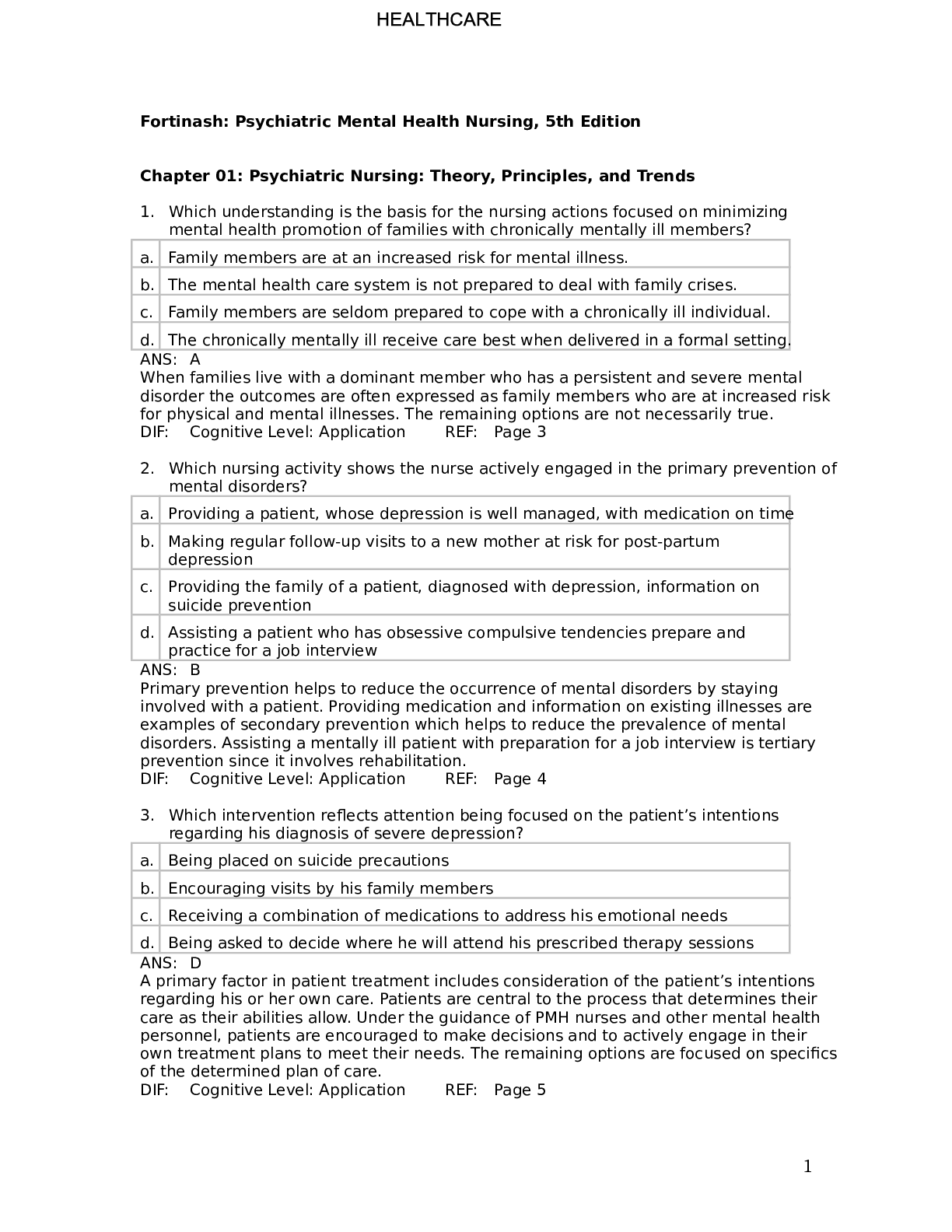
Reviews( 0 )
Document information
Connected school, study & course
About the document
Uploaded On
Feb 12, 2021
Number of pages
207
Written in
Additional information
This document has been written for:
Uploaded
Feb 12, 2021
Downloads
0
Views
62

